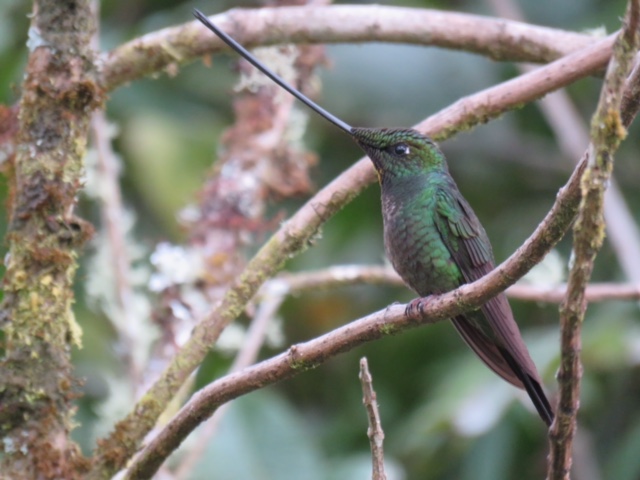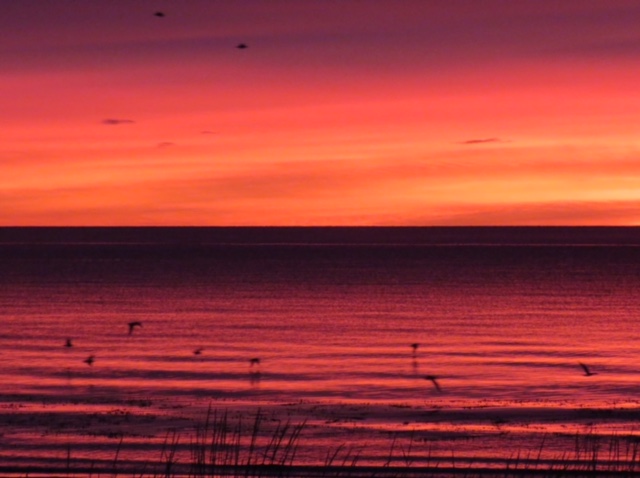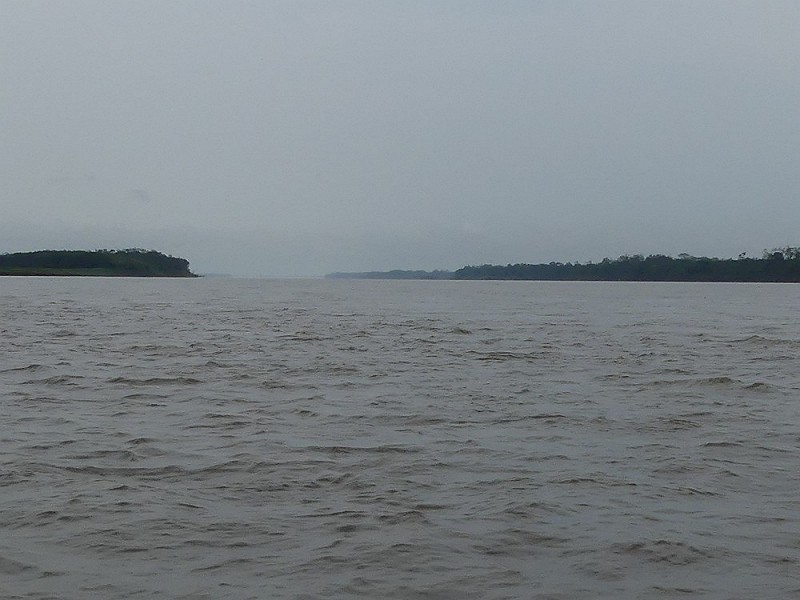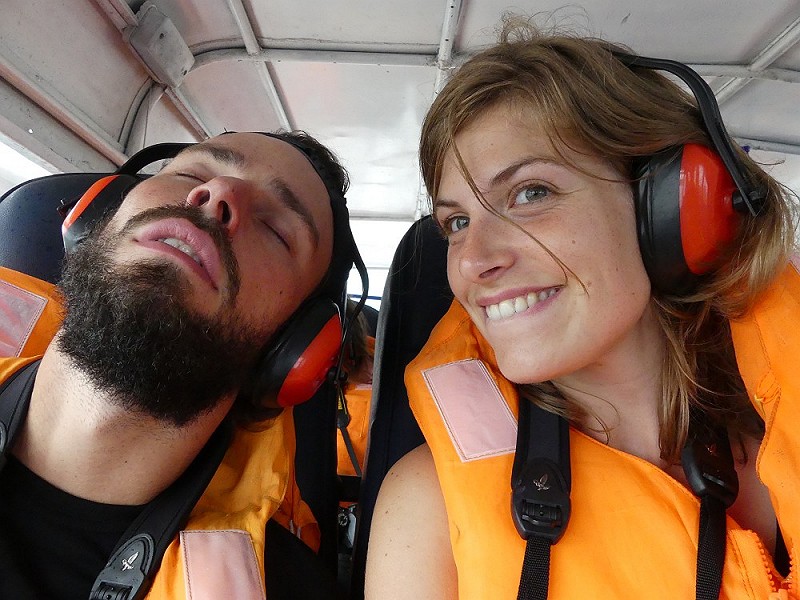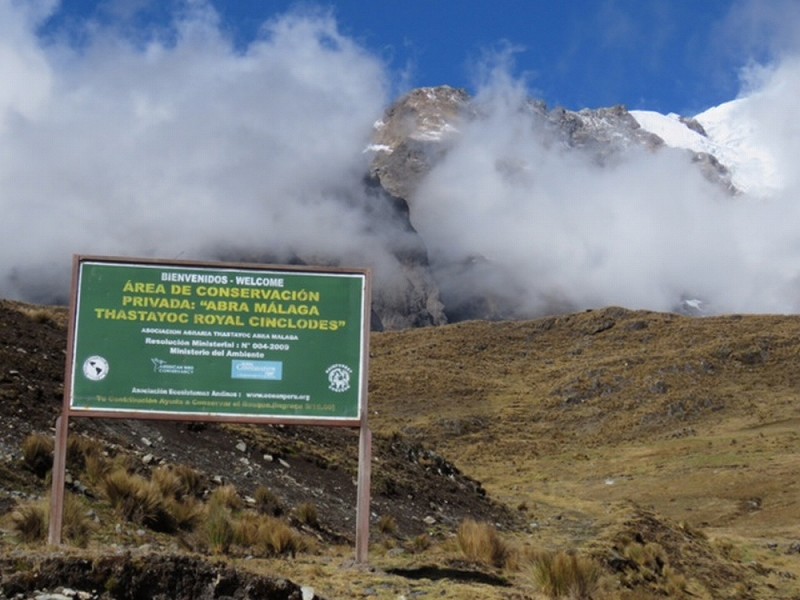Arjan Dwarshuis Biggest Year: 26 juli t/m 15 september
Zoals jullie weten sponsoren wij samen met Swarovski Optik, vogelaar Arjan Dwarshuis. Vanaf 1 janauri 2016 is Arjan in de race om in één jaar tijd zoveel mogelijk vogelsoorten over heel de wereld te zien. Hij wil het record op zijn naam krijgen, daarvoor moet hij meer dan 6.000 verschillende vogelsoorten zien.
Lees hier zijn vorderingen
July 26th DREAM BIRD AFTER DREAM BIRD AFTER DREAM BIRD…
Last night at Sao Paulo airport we’d met Eduardo Patrial, our guide and travel companion for the coming 9 days. From Sao Paulo we would travel to Itatiaia NP, from there to Uba Tuba and onward to Intervales and finally Curitiba. We were very honoured that Eduardo said yes to guide us since he is without doubt one of the best guide in this massive birding country. In addition to this he is a very cool dude, being a top skateboarder and a great storyteller.
We woke up this morning at the Pousada dos Lobos, surrounded by forested hills, perfect! I had barely put up my scope to look at some Blue-and-white Swallows sitting on a wire when I noticed a bird sitting on an exposed snag in the canopy. I couldn’t believe my eyes when I aimed my binoculars, a Swallow-tailed Cotinga! Literally our first bird in the Atlantic Rainforest!!
The morning session at Itatiaia with Eduardo was almost too amazingly good. We literally cleaned up on all the difficult specialties before lunch. One jaw-dropping bird after another meant that Ies and I could hardly control our excitement. Imagine the following list in just a couple of hours’ time: Black-and-gold Cotinga, Speckle-breasted Antpitta, Black-capped Piprites, Sirra do Mar Tyrannulet, lekking Green-crowned Plovercrests, Rufous-crowned Antvireo, Itatiaia Spinetail and Araucaria Tit-spinetail. Wow…
After a quick lunch it was time for the skulkers. We won battle after battle with Mouse-colored Tapaculo, the stunning Rufous-tailed Antthrush and one of my most wanted birds ever, the huge Large-tailed Antshrike!
We ended this magical day with a magical owl. We saw no less than 5 different Rusty-barred Owls (!) displaying, calling, singing, the full Monty… crazy day…
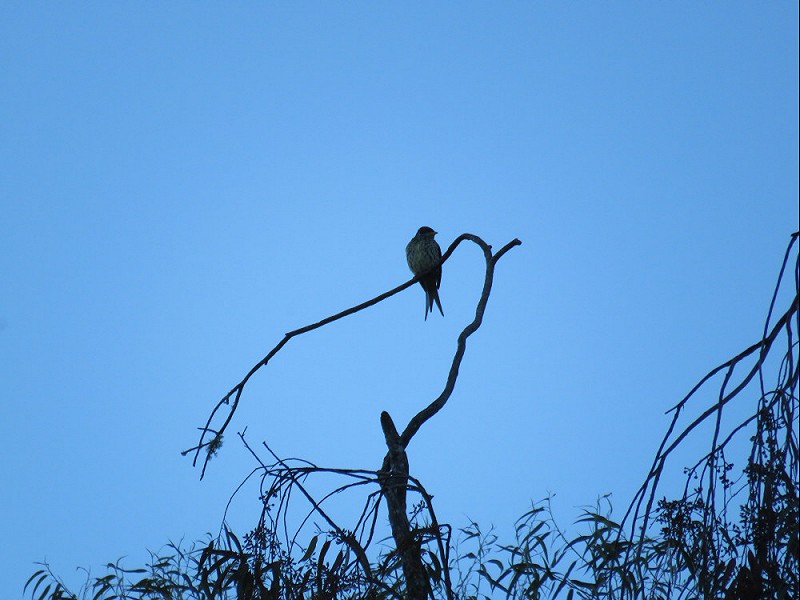 Swallow-tailed Cotinga Phibalura flavirostris (Arjan Dwarshuis)
Swallow-tailed Cotinga Phibalura flavirostris (Arjan Dwarshuis)
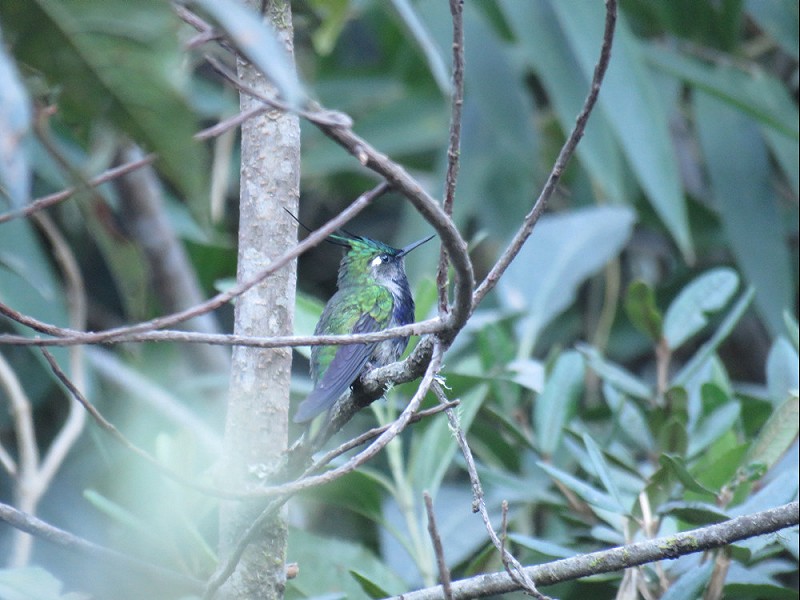 Green-crowned Plovercrest Stephanoxis lalandi (Arjan Dwarshuis)
Green-crowned Plovercrest Stephanoxis lalandi (Arjan Dwarshuis)
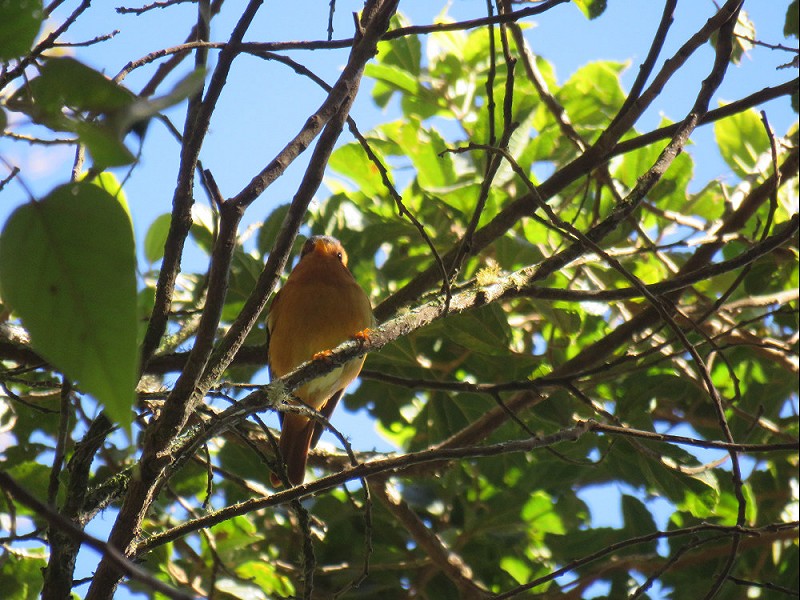 Black-capped Piprites Piprites pileata (Arjan Dwarshuis)
Black-capped Piprites Piprites pileata (Arjan Dwarshuis)
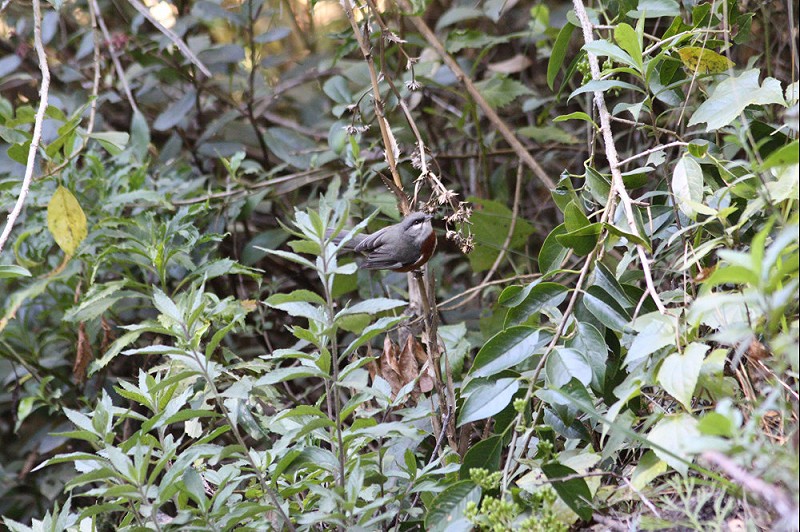 Bay-chested Warbling Finch Poospiza thoracica (Ies Goedbloed)
Bay-chested Warbling Finch Poospiza thoracica (Ies Goedbloed)
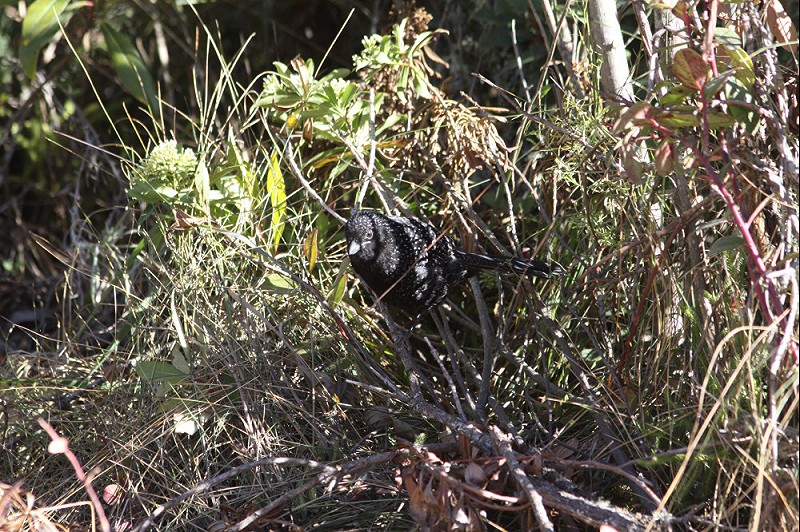 Large-tailed Antshrike Mackenziaena leachii (Ies Goedbloed)
Large-tailed Antshrike Mackenziaena leachii (Ies Goedbloed)
July 27th AND WE THOUGHT IT COULDN’T GET ANY BETTER…
After yesterdays’ madness we thought things could hardly get any better, we were wrong… As we drove down from Itatiaia we made several quick stops along the way which produced Rufous Gnateater and the rare Brown-breasted Bamboo Tyrant, a good start before we drove down to the coastal town of Pereque, the only known site for the recently rediscovered Black-hooded Antwren.
Along the Brazilian coast there are many more incredibly endangered bird species like this beautiful little Antwren, all of this because of deforestation. In fact there is only 5% of the Atlantic Rainforest left and a large part of it is so severely fragmented that some bird population have reached critical levels. This antwren is just one example, but large parts of north-eastern Brazil the situation is even worse. With regards to the antwren it was thought to be already lost forever until recently a tiny population was rediscovered along the edge of secondary forest near Pereque town.
We arrived at the site in the late morning, but somehow it was still very birdy. Bare-throated Bellbirds were singing from several directions and immediately we stumbled upon a flock of different endemic Tanagers. Just 5 minutes after our arrival the Antwren started calling and moments later we had incredible views of one of my rarest birds this whole year, a sad thought, but nevertheless a fantastic bird to see!
For several hours we explored the secondary forest near Pereque and to our big surprise we found one incredibly good bird after another, most birds of course picked up by Eduardo, I’ve rarely seen any birder that sharp before. Are you ready for yet another list of mind blowing rarities? Buff-throated Purpletuft, Slaty Bristlefront, Uncoloured Antwren, Orange-eyed Thornbird, Sao Paulo Tyrannulet, Fork-tailed Tody-tyrant, the beautiful Squamate Antbird, a smashing male Pin-tailed Manakin and just as we were about to leave the icing on the cake; a flock of 2 males and a female Black-legged Dacnis, one of the rarest and most difficult birds of them all!! Hia!
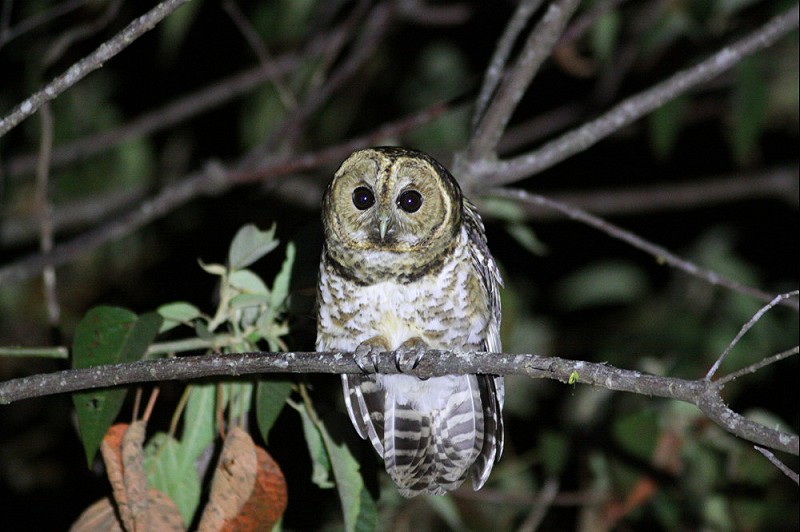 Rusty-barred Owl Strix hylophila (Ies Goedbloed)
Rusty-barred Owl Strix hylophila (Ies Goedbloed)
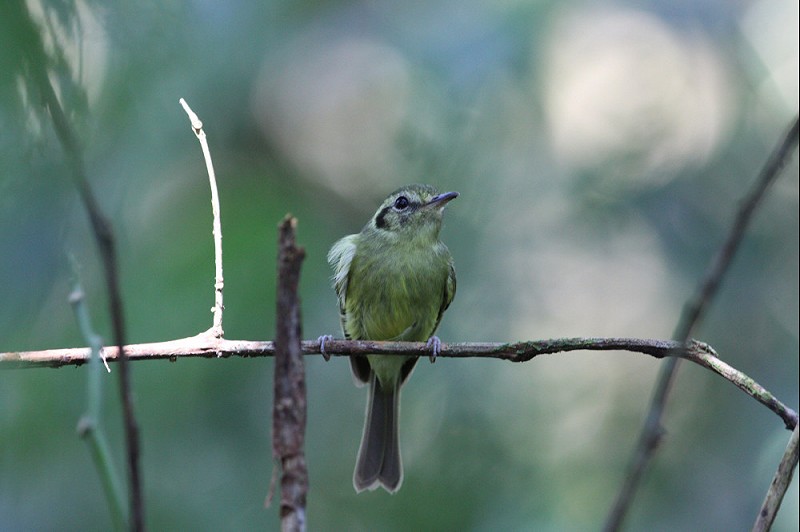 Sao Paulo Tyrannulet Phylloscartes paulista (Ies Goedbloed)
Sao Paulo Tyrannulet Phylloscartes paulista (Ies Goedbloed)
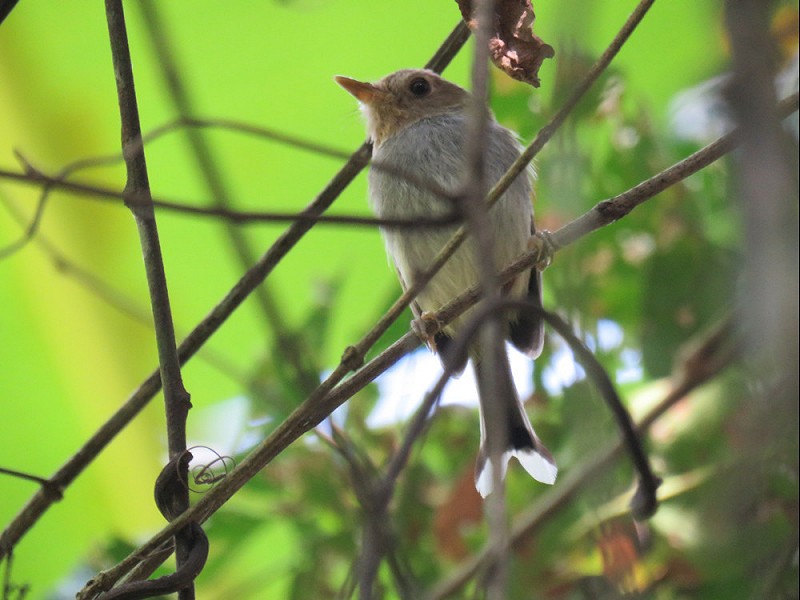 Fork-tailed Tody-Tyrant Hemitriccus furcatus (Ies Goedbloed)
Fork-tailed Tody-Tyrant Hemitriccus furcatus (Ies Goedbloed)
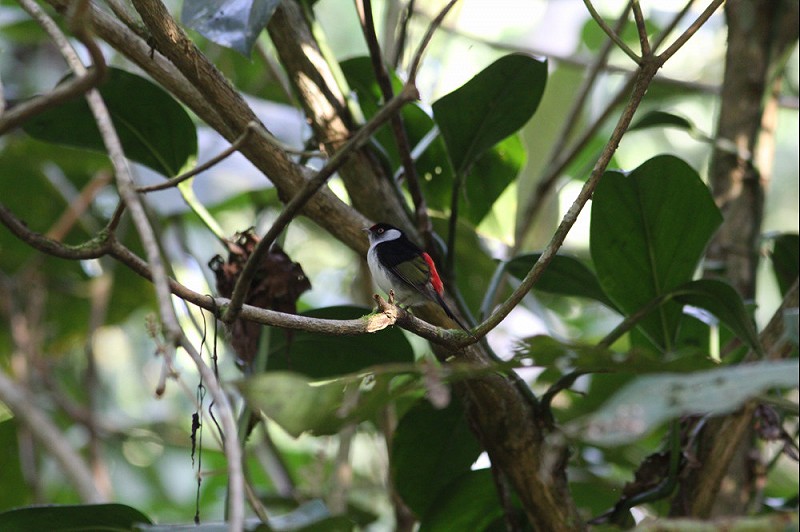 Pin-tailed Manakin Hemitriccus furcatus (Ies Goedbloed)
Pin-tailed Manakin Hemitriccus furcatus (Ies Goedbloed)
July 28th BUT THEN IT GOT EVEN BETTER 🙂
We thought that after seeing so many amazing species yesterday and the day before things had to slow down by now, we were wrong again 🙂
After an early breakfast in our pousada in Uba Tuba town we drove to Angelim Farm, the stakeout for the rare Buff-throated Purpletuft, which we had miraculously already seen the day before. So what else to look for? Well, luckily the hills surrounding Uba Tuba are home to one of the larger tracks of Atlantic Rainforest in Brazil and in these reasonable well protected forests some amazing bird species are found.
With the Purpletuft out of the way our main point of focus was the rare and unique Spotted Bamboowren. A peculiar bird that is now placed in the Tapaculo family, but could well belong to a family of its own.
As we entered the fantastic wide forested path that runs to the farm birds were everywhere and after an hour of nonstop birding action we had covered less than 300 meters. It was simply that good!
Within those first 300 meters we found the rare Salvadori’s Antwren, Tufted Antshrike, Spot-backed Antshrike, Eye-ringed Tody-tyrant, Black-capped Foliage-gleaner, Long-billed Wren, Blond-crested Woodpecker and Black-cheeked Gnateater. Then the Bamboowren started calling. We chased the bird for an hour, but then came that glorious moment when the bird suddenly gave itself up and showed fantastically! This thrilling moment was followed seconds later by an unbelievably showy Rufous-capped Antthrush!
The best birds of the whole day came in the afternoon. First we went to the house of Jonas, better known as the hummingbird man for he has over 10 hummingbird feeders in his garden. The show we got to see here was simply mind boggling with tens of Saw-billed Hermits, Festive Coquet’s, 5 other species of hummingbird and dozens of tanagers turning bald trees into tropical Christmas trees!
After this spectacle we did a little birding along the dirt road behind Jonas’s house and here the magic happened… First a Solitary Tinamu on the road, next a smashing White-necked Hawk – actually our second today, the first was seen briefly – attending an ant swarm and finally the piece the resistance, a Buff-bellied Puffbird!!
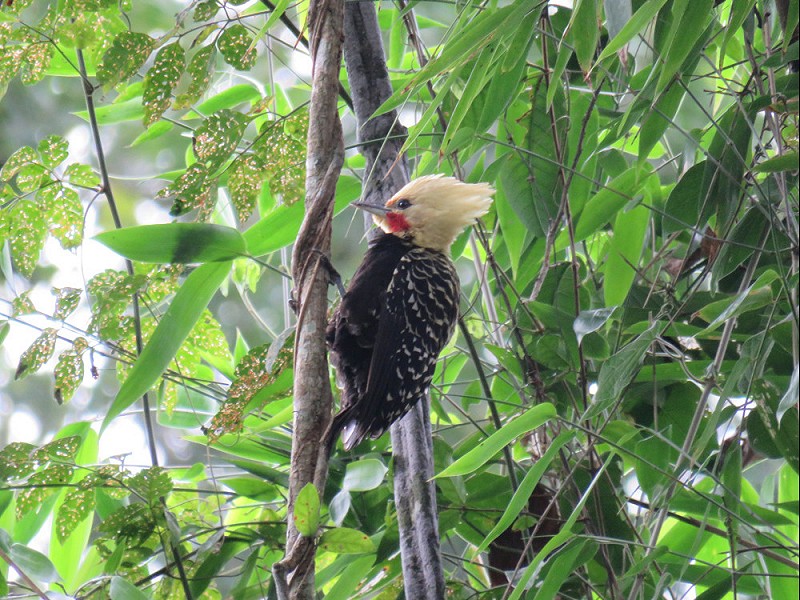 Blond-crested Woodpecker Celeus flavescens (Arjan Dwarshuis)
Blond-crested Woodpecker Celeus flavescens (Arjan Dwarshuis)
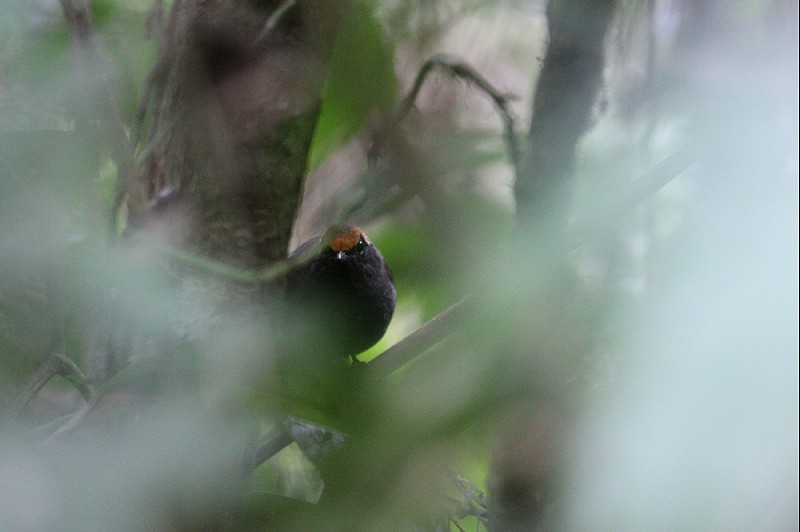 Rufous-capped Antthrush Formicarius colma (Ies Goedbloed)
Rufous-capped Antthrush Formicarius colma (Ies Goedbloed)
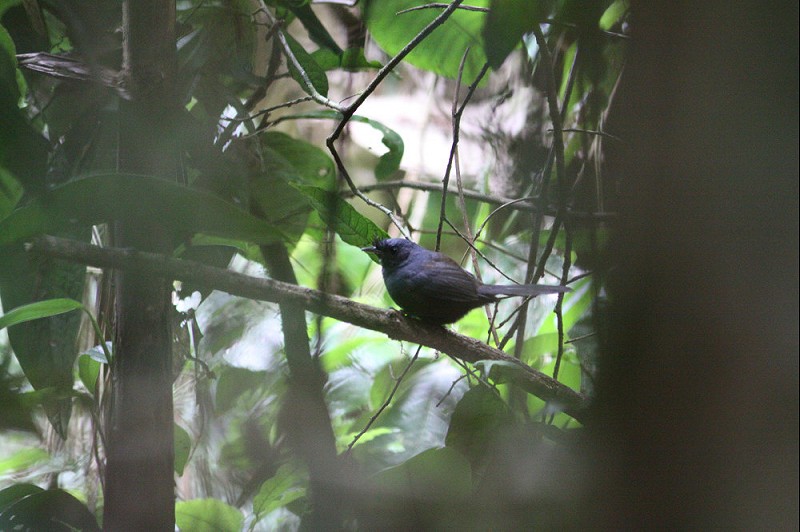 Slaty Bristlefront Merulaxis ater (Ies Goedbloed)
Slaty Bristlefront Merulaxis ater (Ies Goedbloed)
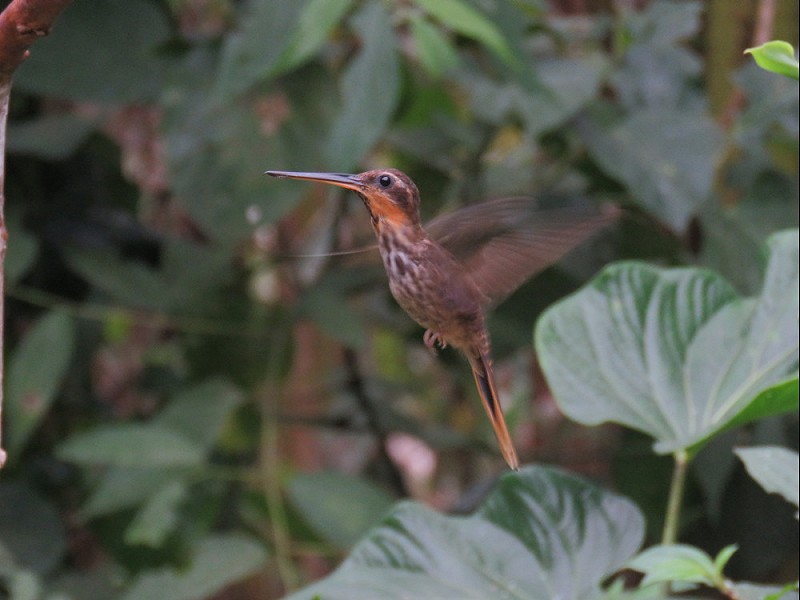 Saw-billed Hermit Ramphodon naevius (Arjan Dwarshuis)
Saw-billed Hermit Ramphodon naevius (Arjan Dwarshuis)
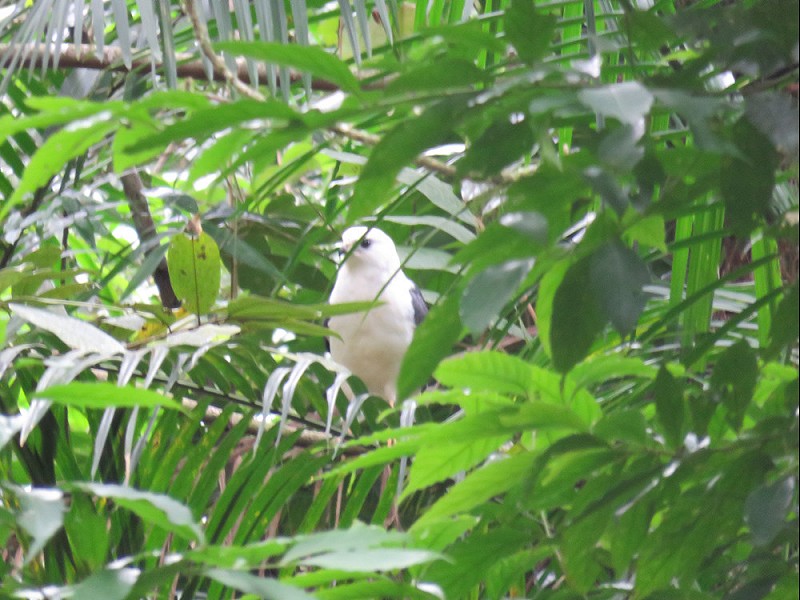 White-necked Hawk Buteogallus lacernulatus (Arjan Dwarshuis)
White-necked Hawk Buteogallus lacernulatus (Arjan Dwarshuis)
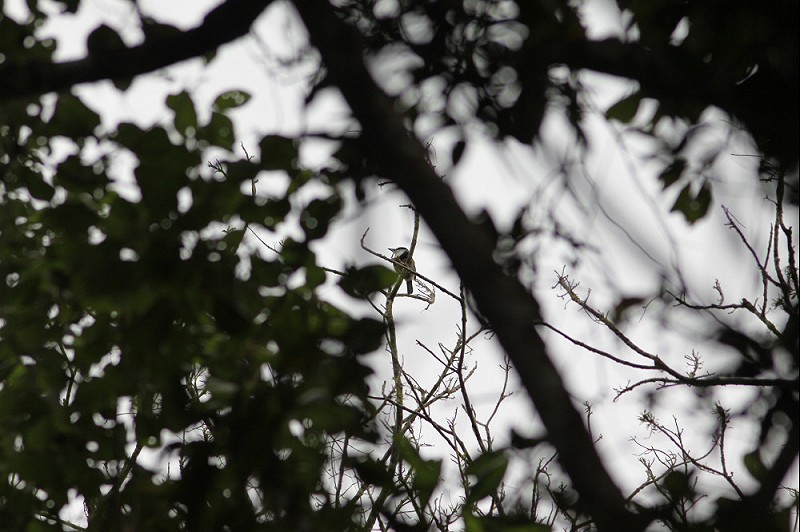 Buff-bellied Puffbird Notharchus swainsoni (Ies Goedbloed)
Buff-bellied Puffbird Notharchus swainsoni (Ies Goedbloed)
July 29th A BIRD THAT IS NOT EVEN ON THE LIST YET!
We had a long day on the road ahead of us, traveling all the way from Uba Tuba, through Sao Paulo to Intervales State Park. Luckily Eduardo had a couple of very interesting stops planned along the way.
Our first stop was at a marshy area in the hills about an hour from Uba Tuba. Here we looked for one of the best tyrants in the world, the Streamer-tailed Tyrant. It took some searching, but eventually we had breath-taking views of a pair displaying on a telephone wire, a sight I will not soon forget. As a by-catch we saw Tawny-headed Swallow and the cool Firewood Gatherer.
The second stop was even more interesting. Eduardo took us to an undisclosed site near Sao Paulo to look for the Sau Paulo Antwren, a critically endangered species that was described only last year and therefore it is not yet on the IOC list!
We had stunning views of a pair of this great looking Antwren in its marshy habitat and picked up Ultramarine Grosbeak while we were there. After that highlight we commenced with the long drive to Intervales, but we had one last stop before we got there. Only 15 minutes form the gate, just after dusk, we taped in a beautiful Long-tufted Screech-owl!
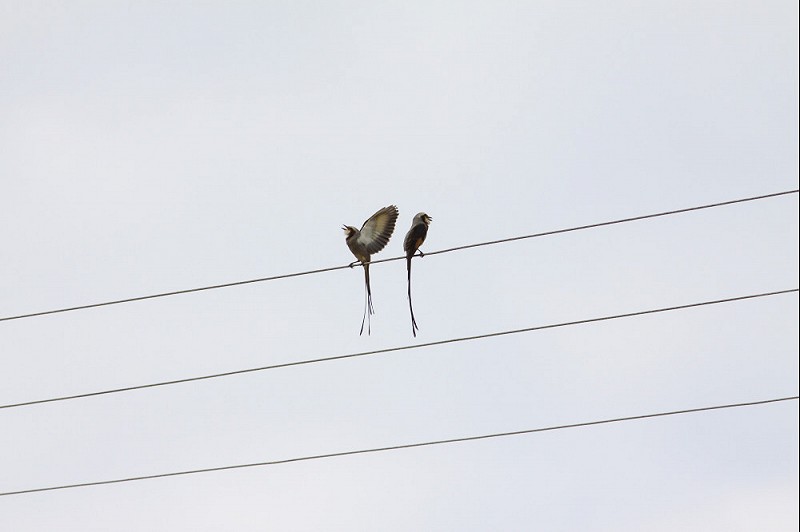 Streamer-tailed Tyrant Gubernetes yetapa (Ies Goedbloed)
Streamer-tailed Tyrant Gubernetes yetapa (Ies Goedbloed)
July 30th TOTAL MADNESS ON THE KARMO ROAD!
Intervales is something special. It is arguably the best and most well-known birding site in the Brazilian Atlantic Rainforest and for a lot of the specialties it is by far the easiest place to find them. The park is well protected from hunting and logging – a rare commodity in corrupted Brazil – and the trailsystem is well maintained. When walking these trails and forested tracks one experiences the Atlantic Rainforest as it once was along the entire east coast of Brazil; beautiful rainforest covered hillsides with mossy trees covered in bromeliad’s and of course plentiful birdlife. It is a sad thought that now only 6% of this amazing ecosystem remains in Brazil…
After picking up local guide Renato we started with a pre-breakfast birding round around the Intervales headquarters which produced Planalto Woodcreeper, Ochre-rumped- and Dusky-tailed Antbird and the petit Ochre-collared Piculet.
After breakfast it was time for the best birding locality in Intervales, the Karmo Road. A 40 km forested track that leads through pristine cloud forest. No people are allowed here except birders with a local guide like Renato.
Just after passing the gate one of my ultimate dream birds started calling, a Giant Antshrike aka ‘The Beast’! We held our breath as Eduardo played the tape, then suddenly a movement in the undergrowth and there was one of the best birds I’d ever seen, ‘The Beast’! 30 centimetres of pure badassness. What a start!
The rest of the morning was fantastic despite the rather bad weather (cloudy and cold with a slight drizzle now and then). We saw Bay-ringed Tyrannulet, Three-striped Flycatcher, Greenish Schiffornis, Green-billed Toucan, Bertoni’s Antbird, Yellow-browed Woodpecker, Sharpbill, Sibilant Sirystes, Crescent-chested Puffbird and best a smashing Red-ruffled Fruitcrow!
After lunch we kept the momentum going with a perched Black Hawk-eagle next to the restaurant. After that highlight we payed a visit to a Variegated Antpitta and a Red-and-white Crake! How you ask me? Well, these birds are currently being fed, so two normally incredibly difficult birds are now very easy.
Next we hit the Karmo Road again; it was total madness! We saw only about twenty individual birds, but almost all of them were rarities. Best were Black-throated Grosbeak, Hooded Berryeater, Brown Tanager, Robust Woodpecker, Saffron- and Spot-billed Toucanet and best a very showy Solitary Tinamu on the road! Brazil is just amazing!
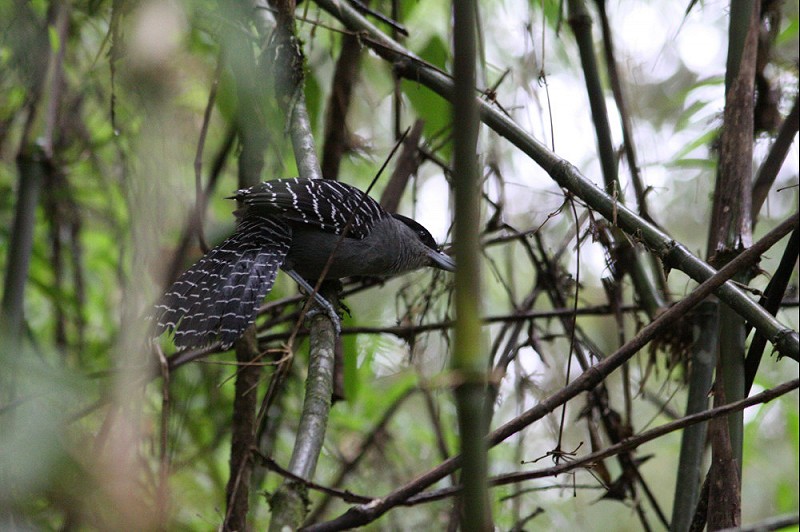 Giant Antshrike Batara cinerea a.k.a. “The Beast” (Ies Goedbloed)
Giant Antshrike Batara cinerea a.k.a. “The Beast” (Ies Goedbloed)
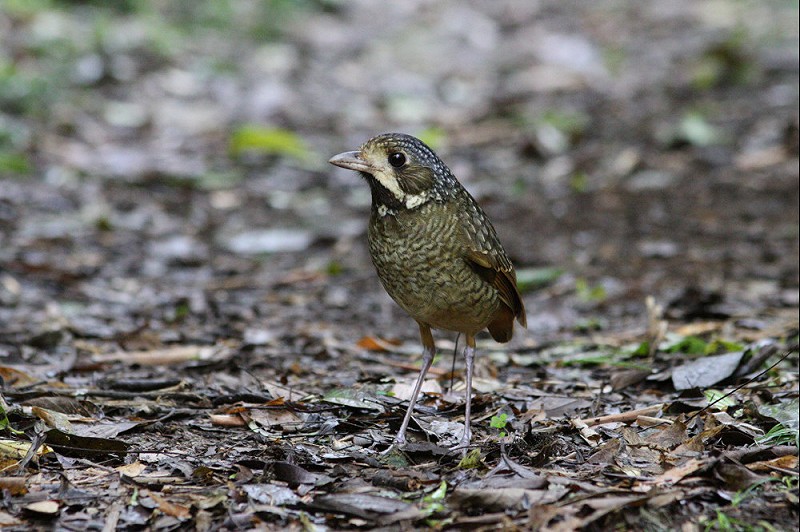 Variegated Antpitta Grallaria varia (Ies Goedbloed)
Variegated Antpitta Grallaria varia (Ies Goedbloed)
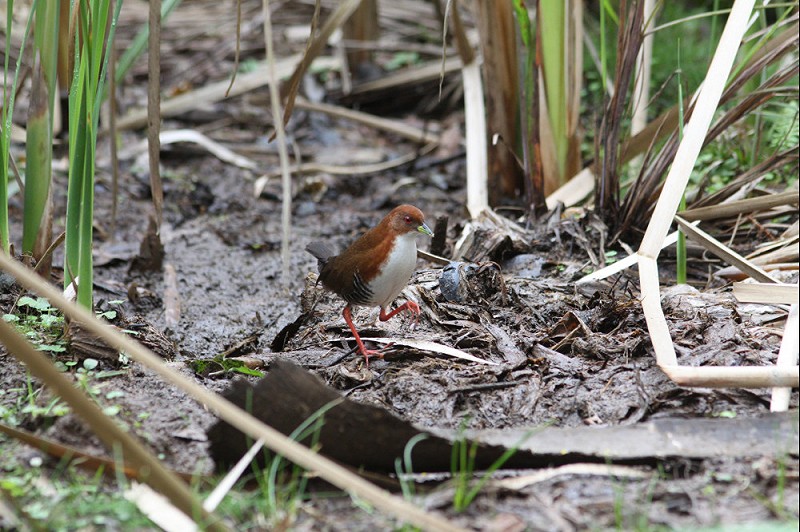 Red-and-white Crake Laterallus leucopyrrhus (Ies Goedbloed)
Red-and-white Crake Laterallus leucopyrrhus (Ies Goedbloed)
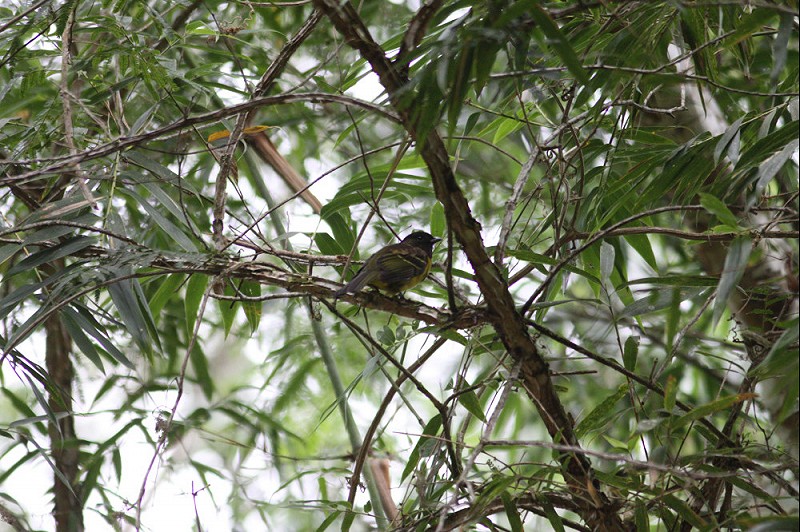 Hooded Berryeater Carpornis cucullata (Ies Goedbloed)
Hooded Berryeater Carpornis cucullata (Ies Goedbloed)
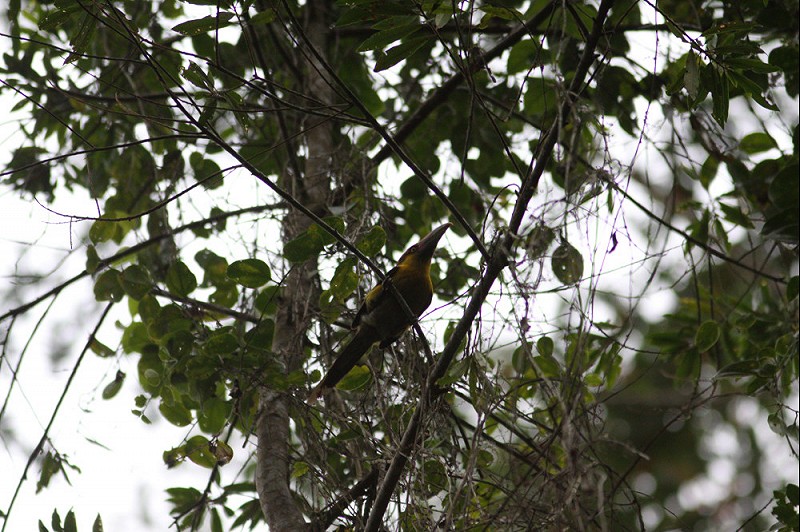 Saffron Toucanet Pteroglossus bailloni (Ies Goedbloed)
Saffron Toucanet Pteroglossus bailloni (Ies Goedbloed)
July 31st TYING THE ENDS TOGETHER AT INTERVALES
Looking at the list of possibilities it looked like today was going to be tough since nearly all the birds we still needed were hard to find rare species, but any day is a fantastic day birding regardless in Intervales.
Eduardo picked a different trail today focussing more on the bamboo specialties and we had a great start with a male White-bearded Antshrike, one of the main Intervales targets. Another great find was the rare White-browed Foliage-gleaner and the Oustalet’s Tyrannulet, but we most enjoyed a very showy Short-tailed Antthrush skulking next to the trail.
After lunch we went to a place were sometimes Spot-winged Wood-quails come to feed and as luck happened to be 5 of these little beauties were present!
Best bird of the afternoon was a totally unexpected out of season male Purple-crowned Plovercrest found by Ies foraging next to the road.
I ended this month with an amazing 950 new birds for my Biggest Year, making this the best month of my entire year so far!
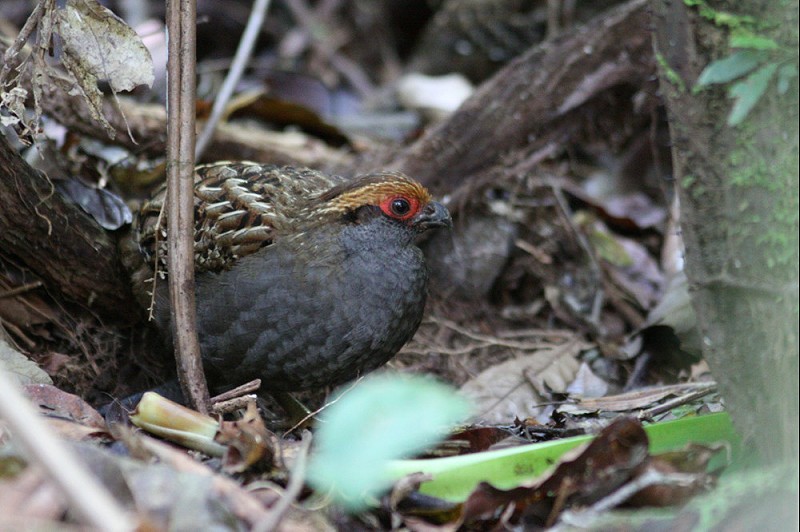 Spot-winged Wood-Quail Odontophorus capueira (Ies Goedbloed)
Spot-winged Wood-Quail Odontophorus capueira (Ies Goedbloed)
August 1st FROM THE HILLS TO THE COAST
We had a long travel day ahead of us so we left Intervales around 6 AM when it was still dark, this proved to be an excellent decision since we found a male Long-trained Nightjar sitting on the road, a most wanted and completely unexpected bird!
We spent the rest of the day on a bendy road driving towards Volta Velha. Upon arrival 2 hours before dark we quickly tried the rare Kaempfer’s Tody-tyrant in its incredibly threatened restinga habitat, one of the many different coastal ecosystems in Brazil that is vanishing at an alarming rate. We only heard the Tody-tyrant so tomorrow we have to work hard to find this little bastard! We did see several adequately named Restinga Tyrannulets at this site.
We ended this day on the road with a fantastic owl, after trying for an owl of so we obtained amazing views of a Mottled Owl while a Black-capped Screech-owl was calling in the background. The latter unfortunately didn’t give itself up.
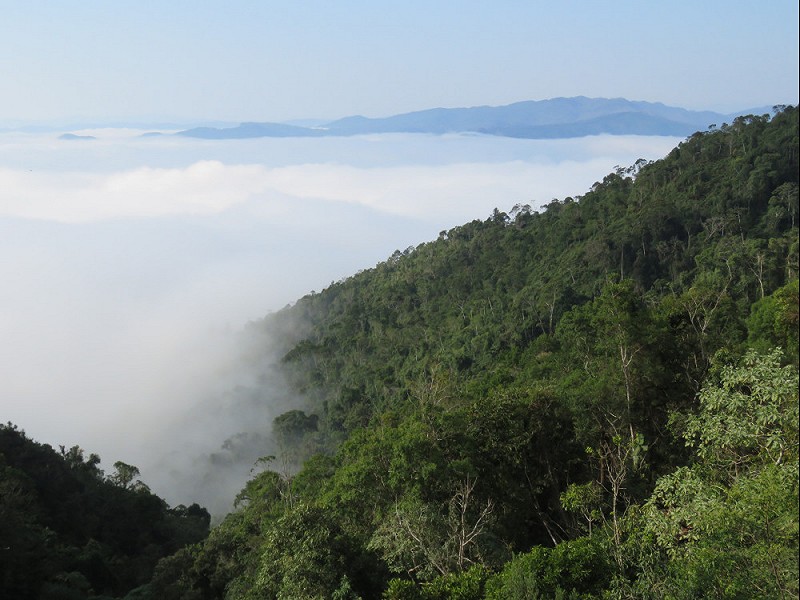 Atlantic rain forest (Arjan Dwarshuis)
Atlantic rain forest (Arjan Dwarshuis)
August 2nd RESTINGA WOODLAND AND VANISHING MARSHES
After breakfast at the very nice Volta Velha lodge we had to move quickly since bad weather was coming our way according to the weather forecast. First we tried for the endemic Scaled Chacalaca which was found without any problem.
Eduardo mentioned that the most difficult bird of the day would be the rare and endangered Black-backed Tanager, but only 15 minutes after nailing the Chacalaca he heard one calling. A tense minute went by, but then we had incredible views of this beautiful bird calling from the canopy of a roadside tree.
In a small pocket of restinga woodland within the Volta Velha reserve we gave the Kaempfer’s Tody-tyrant another try and like yesterday the bird called back once, but immediately shut up. While we kept on trying it slowly started drizzling, time was ticking away. Suddenly the bird called again and Ies picked up on a movement, the Kaempfer’s! We enjoyed this pretty little bird for a couple of minutes before it vanished in the canopy, yes!
We had one last bird to find near Volta Velha, the critically endangered Marsh Antwren. Like its name suggest this bird prefers coastal marshlands which are vanishing at an alarming rate due to cultivation and drainage of water sources along the Brazilian coast. If these last remaining marshes disappear this bird will be lost forever…
We saw no less than 4 of these rare little antwrens and I managed to document this sighting with some nice video.
Near Curitiba we visited another endangered marsh with another endangered inhabitant, the incredibly skulking Marsh Tapaculo. Without much effort we heard two different birds, but we decided not to over-tape this endangered species, which is unfortunately necessary to see it. A heard-only that felt good!
We ended this versatile day at an undisclosed site where – despite the terrible weather – we managed to see a female Sickle-winged Nightjar and hear a Striped Owl.
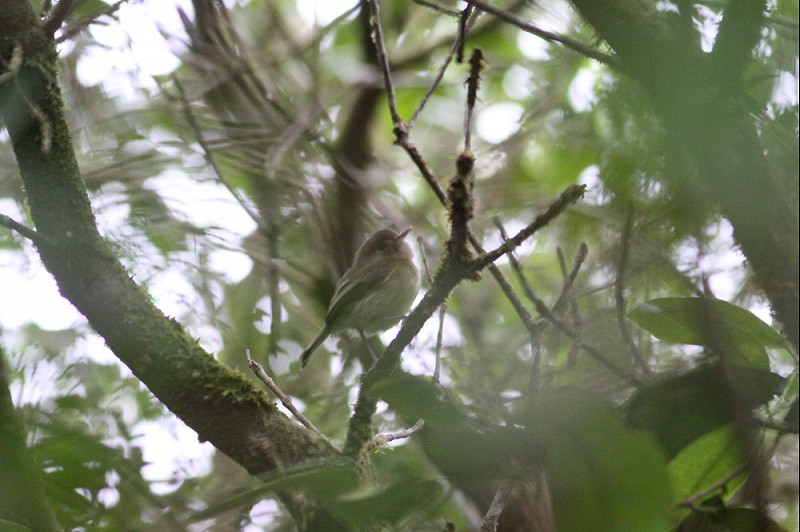 Kaempfer’s tody-tyrant Hemitriccus kaempferi (Ies Goedbloed)
Kaempfer’s tody-tyrant Hemitriccus kaempferi (Ies Goedbloed)
August 3rd ON TO ARGENTINA!
Already our last morning in Brazil with our guide and by now good friend Eduardo Patrial. To find some last new birds we visited a small wetland near Curitiba Airport.
Besides seeing Plumbeous- and Blakish Rail and two very showy Rufous-sided Crakes we found a vagrant which proved to be a new Brazilian species for Eduardo, a Cinnamon Teal! A great finish to an absolutely fantastic trip.
Eduardo has to be one of the best neotropical guides ever and for any birder visiting Brazil I can highly recommend him as a guide and besides being an incredible birder he is a cool dude to hang around!
You can contact him via epatrial@gmail.com.
And now the grand end total… I saw 550 new yearbirds in Brazil making it my best country by far this year! On to Argentina!
August 3rd ENTERING ARGENTINA
Just after midday Ies and I had crossed the border into Missiones, the northeasternmost province of Argentina. At the border we were greeted by Juan Klavins, our guide and travel companion for the next nine days. Together we will drive south through Missiones towards the wet grasslands of Colonia Carlos Pellegrini, from there to Chaco NP, Copo NP and finally to our destination, the city of Tucuman in the far northwest of Argentina. We will visit Atlantic Rainforest, wet grasslands, wet- and dry Chaco and Andean Steppe; all the mayor biomes of the Argentinian north.
Due to a lot of hassle with the car rental company it took us about four precious hours before we were on our way to Uruguai Provincial Park, where we would set up camp for tonight. Within the last two hours of daylight we were able to get two new species; Great Dusky Swift and the beautiful Black Jacobin.
Due to that stupid car rental company we had dipped Iguazu Falls, but I guess birds come before world wonders 😉
August 4th NEW BIRDS ARE GETTING SCARSE, TIME TO MOVE SOUTH
After a cold night in the tent – Ies and I had only sleeping bag liners – we were on the Uruzu bridge, hoping to catch a glimpse of the rare Black-fronted Piping-guan. We waited for over an hour, but the birds didn’t show. With big game birds like this it’s often a matter of luck and in this case we had probably finished all our luck in Brazil.
We did find two good birds, Southern Bristle-tyrant and Blackish-blue Seedeater, but we knew that besides the Guan there was not much else to find anymore, so we decided to head south towards the village of San Pedro. There we would spend the coming two nights with fellow Dutchman and world’s leading woodpecker researcher Martjan Lammertink and his wife and two kids.
We did find an incredibly good bird in a park adjacent to the village of San Pedro, the peculiar and threatened Canebrake Groundcreeper, which Juan skilfully pointed out to us through the thick bamboo, in which the bird makes its home.
August 5th TRACKING THE MOST ELUSIVE WOODPECKER IN THE NEOTROPICS
Around 5:30 AM – when it was still dark – we were on our way to Cruce Caballero Provincial Park. Our goal was to find some special night birds before daybreak. We started very well with two male Long-trained Nightjars on the road, but the real fun started upon arrival at the Cruce Caballero headquarters. Both Tawny-browed Owl and the rare Silky-tailed Nightjar were calling actively. We decided to start with the Tawny-browed Owl because we had played hide-and-seek so many times in Brazil without actually seeing it. This time we finally had success with this fantastic species which showed very well! The nightjar however refused to leave cover.
After this early success we continued with an excellent set of difficult birds in the form of Creamy-bellied Gantcatcher, Pavonine Cuckoo and Ultramarine Grosbeak. Best, however, were two exceptionally showy Planalto Tapaculos.
Back at Martjan’s place in San Pedro, his wife Utami had just prepared lunch for us while Martjan himself had just returned from five gruesome days in the field. He had some exciting news. He and his team had caught and radio tagged their first Helmeted Woodpecker of this season! Even better news was that Martjan suggested to visit a sleeping hole of a female Helmeted Woodpecker with us this very afternoon!
And so it happened that we were on our way to Cruce Caballero for the second time today, this time with a fair chance of seeing one of the rarest and most elusive woodpeckers in the Neotropics!
First we had to walk for an hour or so through the beautiful Atlantic Rainforest of Cruce Caballero (picking up one of Martjan’s camera traps along the way) before we finally arrived at the base of a huge tree. Martjan silently pointed at a natural opening in this tree: ‘this is where the bird will hopefully fly in between 6 and 6:25 PM, if by then it hasn’t shown up, it must have found a different roosting place’. It was just 5 PM, which meant that we had one hour of waiting ahead of us, one hour of serving as a fast-food restaurant for mosquitos.
Finally it was 6 PM and the moment of truth had arrived, would the bird show up? Then it happened! A bird swooped overhead and landed in a tree next to us, we aimed our binos, it was the Helmeted Woodpecker! For the next 10 minutes we watched this absolutely stunning bird in absolute silence, while it performed its whole roosting ritual, a mesmerizing experience!
August 6th RARE BIRDS IN VANISHING GRASSLANDS
Around 5 AM we said goodbye to Martjan and his family and started heading southwest towards Colonia Carlos Pellegrini, the Argentinan equivalent of the Pantanal. It is here that some rare and endangered grassland species have their stronghold. We hadn’t included this place in our original itinerary, but since we cleaned up the Atlantic Rainforest we could take two days off our Missiones itinerary.
After about six hours driving we turned right onto a dirt road that took us into a vast area of grassland and farms. Our first big target was the vulnerable Black-and-white Monjita, which we found rather quickly perched on a roadside fence. Another good find was a Bearded Tachuri. Then began the search for one of the most threatened birds of Argentina, the Yellow Cardinal. This beautiful species is declining rapidly all over its already fragmented range. Threats include habitat loss, nest parasitism by Shiny Cowbirds, chick predation by botflies and illegal capture for the pet trade.
The weather wasn’t ideal with strong winds and cloudy sky, so we struggled to find this rare bird. Then Juan asked permission at a small local farm to walk around the bushy habitat, a brilliant move because only five minutes of searching later we saw three Yellow Cardinals, including one stunning male.
After checking in at the wonderful Ecoposada del Estero – which lies adjacent to a big marsh full of birds – and a quick lunch, we went searching for our most wanted species in these wet grasslands, the adequately named Strange-tailed Tyrant. Weather conditions had gotten worse after lunch, which meant that it was getting dark fast. We had nearly given up on seeing the bird today when Juan suddenly hit the brakes, he had found a male Strange-tailed Tyrant sitting on the fence! What a great bird to finish the day with!
August 7th FROM THE GRASSLANDS TO THE WET CHACO
After a quick breakfast we packed our bags and headed west. Our first stop was at the same place where we had seen the Strange-tailed Tyrant the day before. Luckily, today we found no less than eight birds of which five adult males. What an amazing species!
Another unexpected find was a Bay-crowned Wren-spinetail, a difficult species anywhere and a fantastic record this far north!
When Juan saw a suitable looking field we made another stop and looked for the threatened Ochre-breasted Pipit, which after some taping came flying overhead, calling loudly.
We arrived at the Chaco NP campsite around 9 PM and upon arrival we were pleasantly surprized, staying there was free of charge and there were hot showers, Wi-Fi and charging points! We were already dozing off in our tent when suddenly a Great-horned Owl started calling right above our tents so Ies and I went out on our flip-flops and obtained some fantastic views.
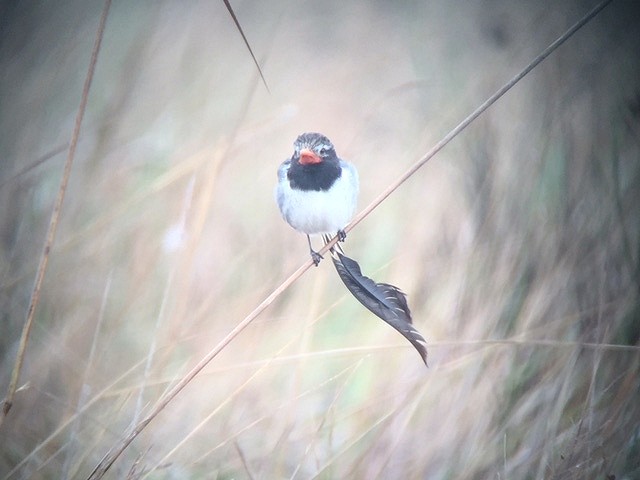
August 8th CHACO NP
To me the chaco forest is a bit like the African miombo woodland. It is a biome not well known and rarely visited by foreign birders (except a tiny bit of chaco in the northern part of the Pantanal), still there is a wide range of bird species found only in this specific forest type. The chaco can be divided in the wet and the dry chaco, we would visit the latter region first.
Two fantastic large woodpeckers make their home in the chaco, the Cream-backed- and the Black-bodied Woodpecker. Both were calling and drumming around the campsite when we woke up, but we only managed to see Cream-backed.
After a quick breakfast we went into the forest in search of chaco specialties. Great Rufous Woodcreeper, White-fronted Woodpecker and a very sneaky Spotted Rail were among the highlights.
For the afternoon session we decided on visiting some of the flooded areas outside the national park, but characteristic for the Chaco. Our big target was the minute Ringed Teal and to our pleasant surprise it was locally common. In addition to this cute little duck we saw an unexpected southern migrant, Black-capped Monjita, alongside the first northern waders like Greater- and Lesser Yellowlegs and Pectoral Sandpipers. North meets south, very fascinating indeed.
August 9th FROM THE WET TO THE DRY CHACO
When we woke up today there was a fantastic pair of Black-bodied Woodpecker foraging right next to our tent, a fantastic start of the day! Since we had seen most of the wet chaco species we decided it was time to continue towards Copo NP, which is situated in the dry chaco.
The landscape gradually got dryer the further we got west and with that dryness the first specialties appeared, like Many-coloured Chaco-finch and the funny looking Chaco Puffbird.
After checking in at a small hostel in the nearby dusty village of Pampa de los Guanacos, we proceeded towards the entrance of Copo National Park. On the track were several Brushland Tinamous, but the biggest surprise was a GIANT ANTEATER that crossed the road about 200 meters in front of us!
We could only bird around the entrance of Copo since apparently there was a cheeky Puma that had harassed some tourist lately. Of course we wanted to go look for that Puma, but the park staff thought different about that unfortunately.
Before dusk we found a beautiful Olive-crowned Crescentchest, several Crested Gallitos and the localized Quebracho Crested Tinamou, hopefully we would see these specialties tomorrow.
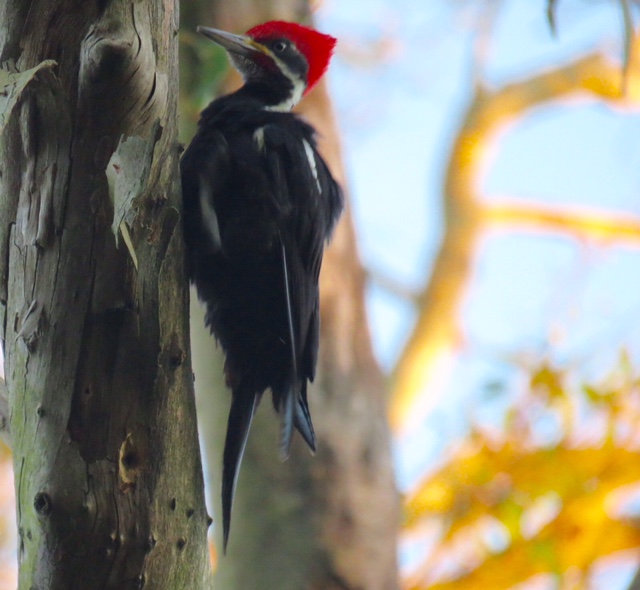
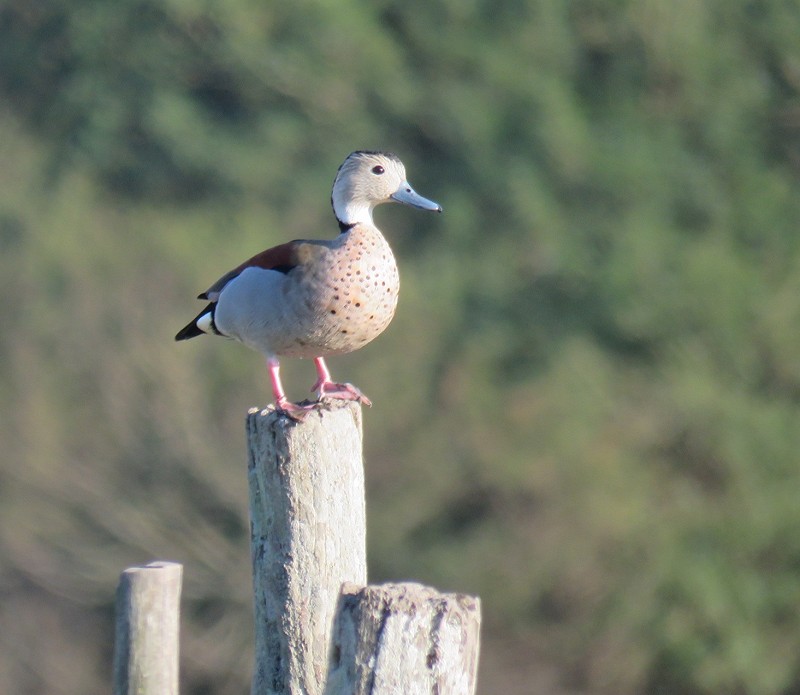
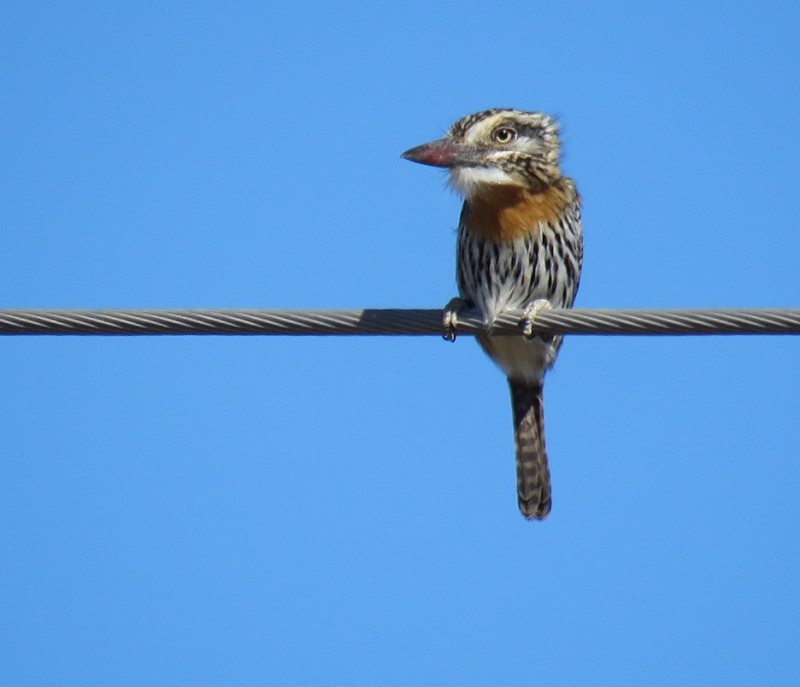
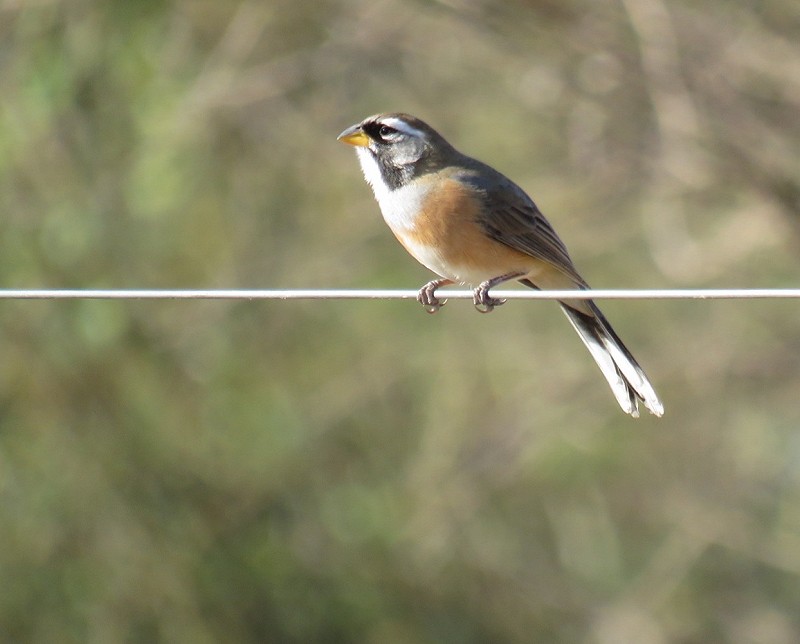
August 10th SEARCHING FOR THE QUEBRACHO CRESTED TINAMOU
One chaco specialty in particular was very high on our wish list, the range restricted and very cool looking Quebracho Crested Tinamou. This peculiar bird is only found in the northern part of Argentina and southern Bolivia and is nowhere easy to find. Early morning we heard one calling, but seeing the bird proved impossible. This was also the case for a Black-legged Seriema, another most wanted chacospecialty.
It was sad to see that most large trees had disappeared from this area. Like the cerrados in Brazil and themiombo woodland in Southern Africa this a much underappreciated ecosystem and with the eyes of the world focussed on logging of the worlds’ rainforest, these less well known biomes could be in much more trouble than we think.
In the afternoon we got lucky! As we drove back to the park we spotted a distant Tinamou on the track in front of us, a Quebracho! I managed to take some record shots before it disappeared in the forest, awesome!
Another much unexpected find was a female Carbonated Siera-finch, found and identified by Juan. This poorly understood migrant had never before been recorded this far north!
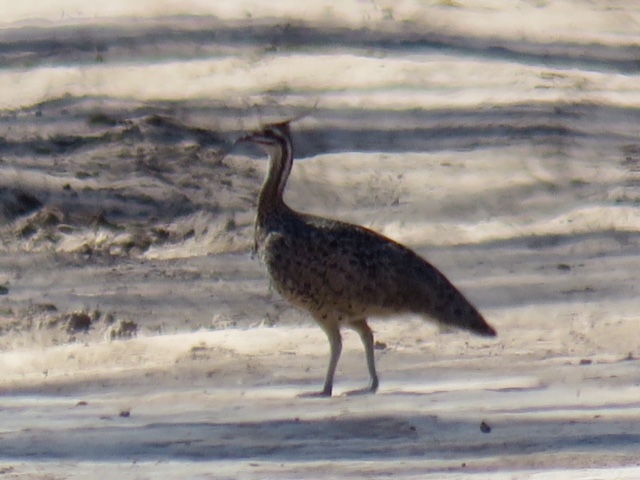
August 11th TO TUCUMAN!
We had 600 km of driving ahead of us so we left early. However we had a couple of really big targets along the way Tucuman so no need to get bored!
When we were just an hour on the road, we struck gold when we found a Spot-winged Falconet sitting on a roadside pole. This diminutive raptor can be hard to find so it was great to see it this well.
But it got even better… Juan decided to take a sandy side track through some dry chaco that looked promising. First there was a big disappointed when we found the feathers of a freshly killed Black-legged Seriema, but as we made our way back one suddenly crossed the track and showed amazingly! Yes!
Our final stop was in de sieran-chaco near Tucuman, where we looked for our two last possible chacospecialties, the Chaco Earthcreeper and the beautiful Black-crested Finch. I was rather sceptical about finding the Earthcreeper especially, but Juan’s stakeout proved spot-on! We found both and finished our road trip through northern Argentina with an almost perfect score!
Arjan Dwarshuis
http://www.arjandwarshuis.com/#biggestyear
http://world.observation.org/arjan.php
PLEASE MAKE A DONATION NOW!
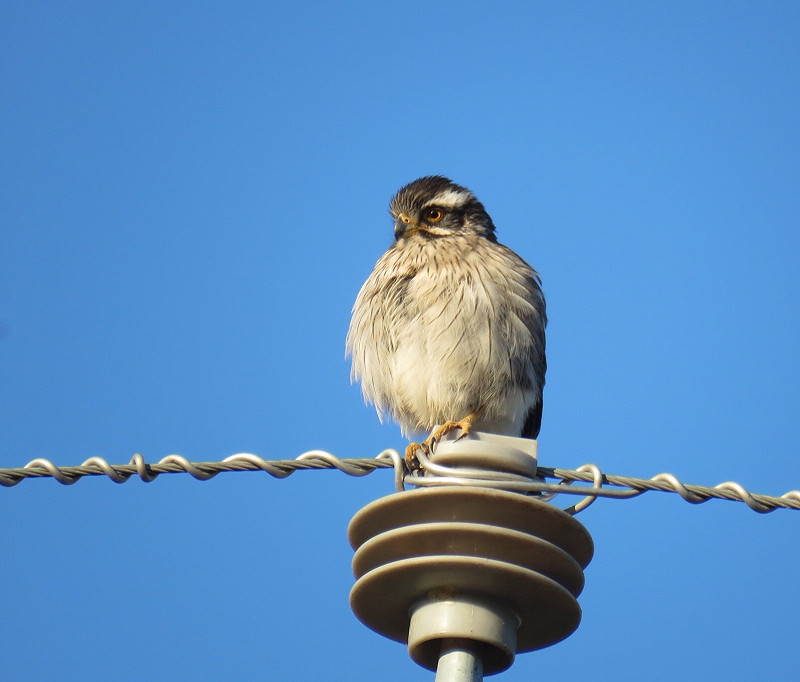
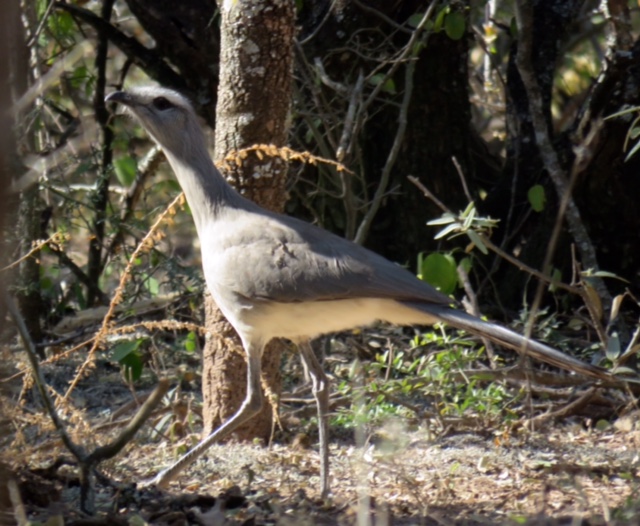
August 12th FROM THE YUNGAS TO THE DESERT
Last night we had arrived in San Miguel de Tucuman, where we got a heart-warming welcome from Giselle Mangini and her boyfriend Facundo Gandoy, two ornithologists and fanatic birdwatchers who would take Ies and me on a five day mega road trip through northwestern Argentina.
After spending the night at Giselle’s parents place we left around 5 AM and drove into the mountains above Tucuman. While it was slowly getting light we found ourselves amidst lush ‘Yungas’ cloud forest and down below us ran a fast flowing river. Here we would look for our biggest target of the trip, the endangered Rufous-throated Dipper. This bird can sometimes be difficult to find, but not this time! Within two minutes Ies had found a pair and for over half an hour we were treated to a Dipper-fiesta! Yes!
While watching the Dippers, Facundo found a calling White-browed Tapaculo and after some playback we had awesome views of this skulker. Other highlights at this location were the endemic Yellow-striped Brush Finch and several Mountain Wrens.
As we drove further up the landscape changed into pre-puna grasslands and not long thereafter we made our second planned stop near a gully. Here we quickly found the endangered Tucuman Mountain-finch, another big target!
Next we made a tough, but very scenic hike towards a territory of the rare Scribble-tailed Canastero. The one hour walk was more than worth it, because eventually we had fantastic views of a pair. Other good birds along the way were Puna Canastero and Buff-breasted Earthcreeper.
From here it was downhill again towards the intermontane desert environments near Cafayate, along the way making a lot of stops to look for birds.
As we set up camp I counted an incredible 56 new species for the day, our roadtrip had started with a bang!
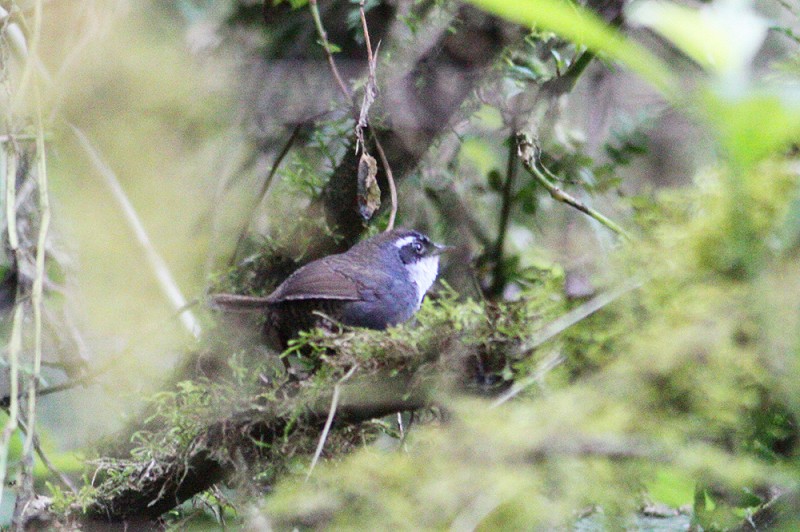 White-browed Tapaculo Scytalopus superciliaris (Ies Goedbloed)
White-browed Tapaculo Scytalopus superciliaris (Ies Goedbloed)
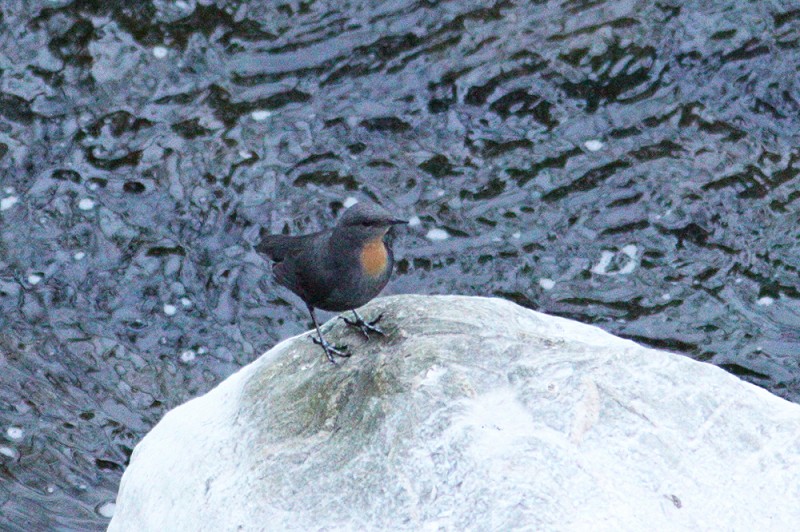 Rufous-throated Dipper Cinclus schulzi (Ies Goedbloed)
Rufous-throated Dipper Cinclus schulzi (Ies Goedbloed)
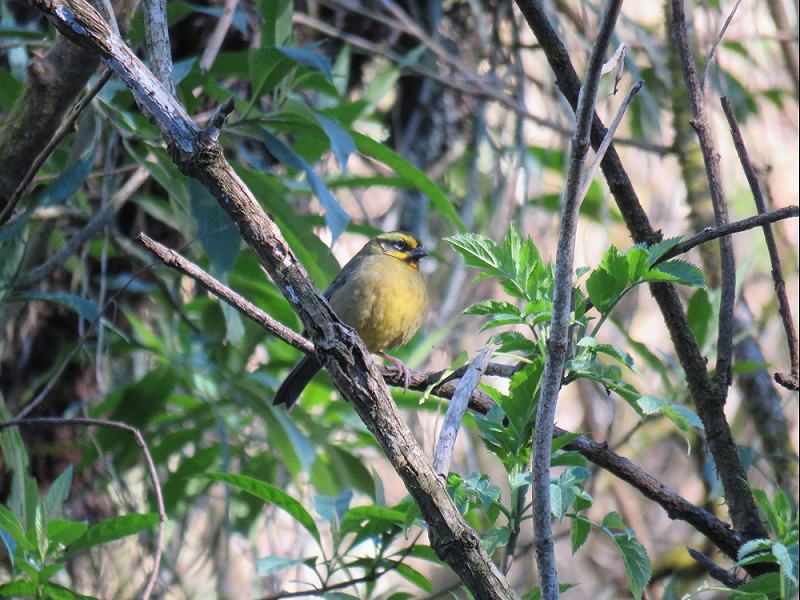 Yellow-striped Brush Finch Atlapetes citrinellus (Arjan Dwarshuis)
Yellow-striped Brush Finch Atlapetes citrinellus (Arjan Dwarshuis)
August 13th ACROSS THE ANDES!
After packing up our tent we drove a short distance to some cactus-dominated landscape near Cafayete to look for the endemic White-throated Cachalote. The bird gave us a bit of a run-around, but eventually we had great looks of a pair, our last Cachalote species was in the bag.
From Cafayete it was a long drive across a dusty road – picking up Brown-backed Mockingbird along the way – before we finally started climbing up into the mountains above Salta. The landscape gradually changed from desert to puna grassland, the scenery was absolutely breathtaking.
We sought our first target in an area dominated by large boulders and rocks, the adequately named Rock Earthcreeper. As is often the case with furnarids a short burst of playback was enough to persuade the bird to show itself, another great member of a fantastically diverse family. Another good find here were three wintering Cinnamon-bellied Ground-tyrants.
From about 3400 meters we started to descent again until we reached the first maquis scrub, here we could find a very interesting set of habitat specific targets, the Rufous-bellied Saltator, Straight-billed Earthcreeper and Maquis Canastero. Due to Giselle’s and Facundo’s fantastic preparation and site info we managed to find all these targets.
We struggled with finding one target, the Zimmer’s Tapaculo, but just before it got dark, at the last gully we tried we finally got a response which resulted in fantastic views.
We ended this perfect day with a suiting finish, two amazingly showy Yungas Screech-owls.
Around midnight we arrived at Giselle’s and Facundo’s house in Salta where I connected with the Wi-Fi network. I received some devastating news… My friend Dušan Brinkhuizen, who I would be birding with for two weeks in Ecuador, had horrifically broken his leg and ankle. Naturally he was in the hospital, physically and mentally almost succumbing from pain. I felt sick hearing this and I hope that my friend will recover as soon as possible. Hold in there buddy! In the meantime I will have to come up with a backup plan for Ecuador, with just five weeks till my arrival in Quito…
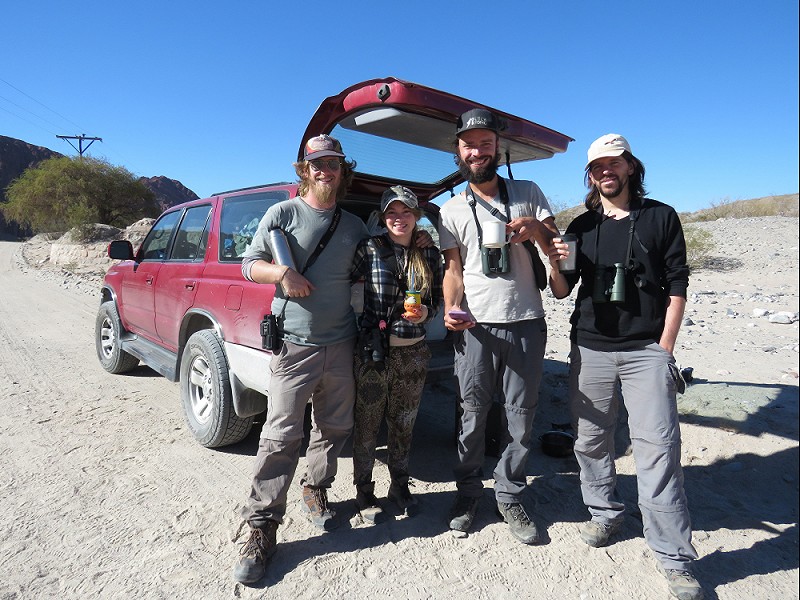 Roadtripping! (Arjan Dwarshuis)
Roadtripping! (Arjan Dwarshuis)
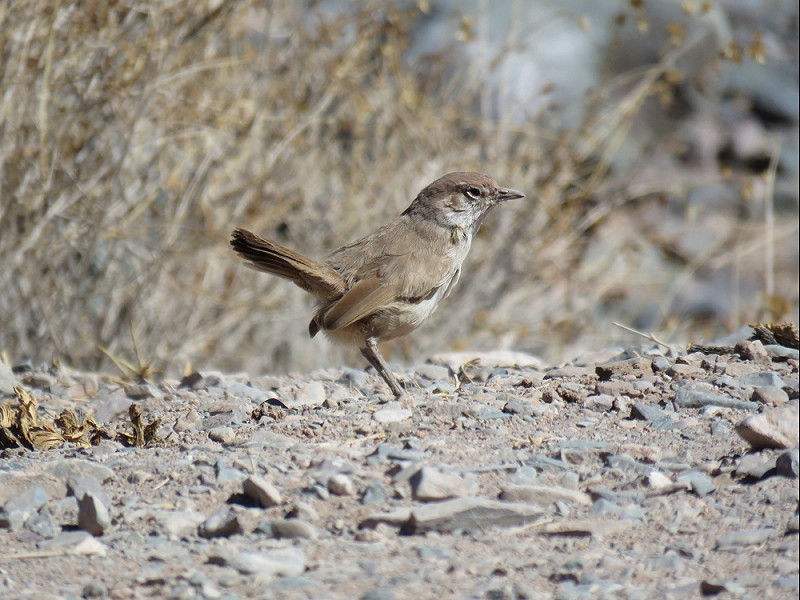 Sandy Gallito Teledromas fuscus (Arjan Dwarshuis)
Sandy Gallito Teledromas fuscus (Arjan Dwarshuis)
August 14th CALILEGUA NATIONAL PARK
So far the trip that Giselle and Facundo have put together surpasses all expectations, but this morning they told us that we would take things to the next level. Since we were doing so well, they decided that we would travel all the way to the Bolivian border to look for some very little known birds that barely creep into Argentina, exciting stuff!
First however, we would visit more familiar territory, namely the dry forest above Salta and the infamous Calilegua NP.
Near Salta our main target was the range restricted Tucuman Parrot, but several potential future splits – Great Pampa Finch and Stripe-headed Sparrow – make this region even more special. It took us a fair bit of searching – with Dot-fronted Woodpecker, Sclater’s Tyrannulet and White-faced Dove as welcome distractions – before we eventually found a perched Tucuman Parrot.
After picking up some empanadas it was time to drive north towards Calilegua NP, where we arrived around mid-day. During the heat of the day birding was tough, but still we managed to find Ochre-cheeked Spinetail and Plumbeous Tyrant by the skin of our teeth.
We drove all the way up to the highest part of this stunning park whish reminded me in some way of the fabled Peruvian Manu Road with pristine forest covering steep hillsides. We birded until dusk – we still had to drive a huge distance north – and managed to find Glossy-black Thrush, Yellow-collared Macaw and White-browed Brushfinch.
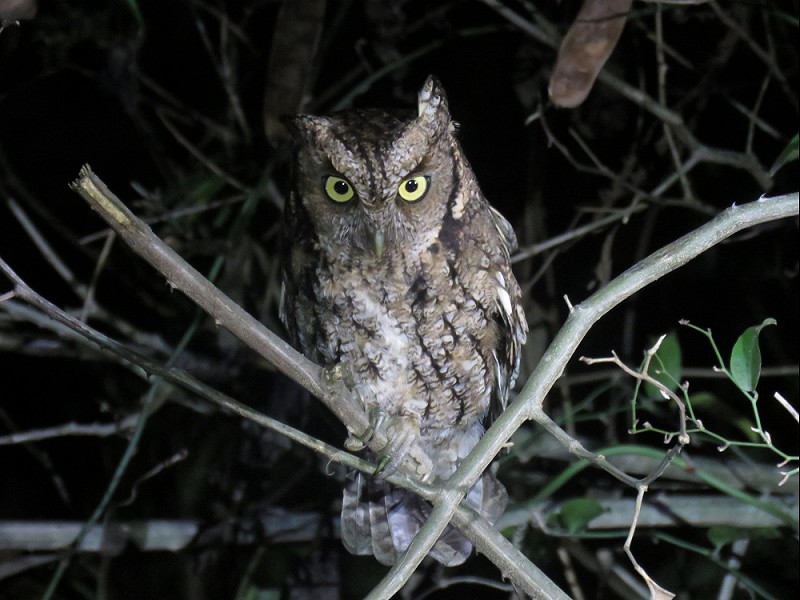 Yungas Screech-owl Megascops hoyi (Arjan Dwarshuis)
Yungas Screech-owl Megascops hoyi (Arjan Dwarshuis)
August 15th HIGH ALTITUDE PUNA LAKE BIRDING
We had spent the night the night in a small village half way to Laguna de los Pozuelos and at daybreak we continued our journey towards this stunning high altitude puna lake.
The landscape along the way was absolutely breath-taking with rugged mountains, snowy peaks and Vicugnas and Guanacos dotted across the puna grassland.
When we arrived at the lake we noticed that the water level was alarmingly low, maybe as a result of El Nino or possibly simply because of global warming. Dead birds were littered across the shore of the lake, clearly there was a lack of food.
Birds however were plentiful, probably because the remaining water in Los Pozuelas was the only water source in the area. We found some amazing species on the flat desert puna bordering the lake like Lesser (Puna) Rhea, Golden-spotted Ground-dove and the beautiful Andean Avocet.
Luckily we quickly found our main targets on the lake itself, three species of Flamingo – Jameson’s- , the endangered Andean- and the more common Chilean Flamingo – and best, a juvenile Horned Coot. The biggest surprise here was a Semipalmated Sandpiper which turned out to be about the 5th record for Argentina and the first for the entire southern part of the Andes Mountains!
From Laguna de los Pozuelos we continued our journey north to Yavi, a small village just five kilometers from the Bolivian border. Here we found the range-restricted Citron-headed Yellow-finch and as dusk fell over this scenic little town we checked in at a hostel to spend the night.
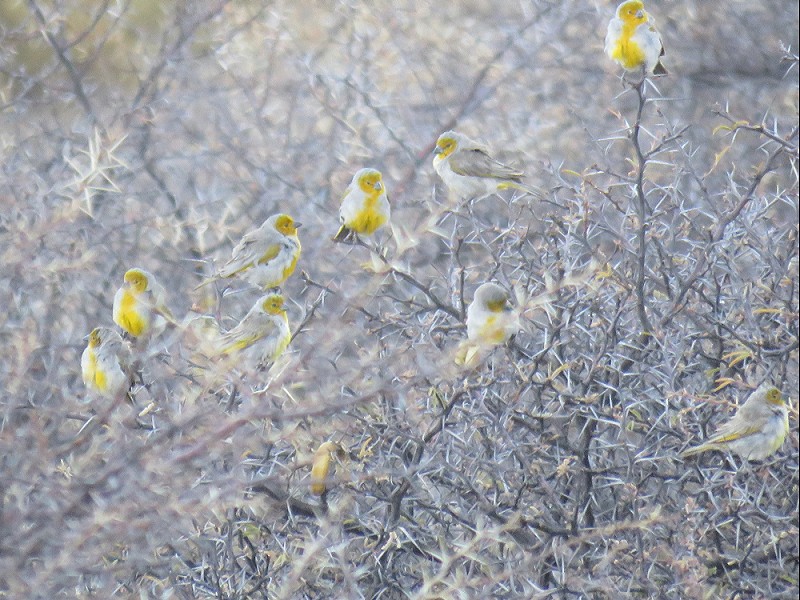 Citron-headed Yellow-finch Sicalis luteocephala (Arjan Dwarshuis)
Citron-headed Yellow-finch Sicalis luteocephala (Arjan Dwarshuis)
 Black-hooded Sierra-finch Phrygilus atriceps (Arjan Dwarshuis)
Black-hooded Sierra-finch Phrygilus atriceps (Arjan Dwarshuis)
August 16th TO 4500 METERS AND DOWN AGAIN!
Already our last day in the rugged mountains of northwestern Argentina, a sad thought since we had such a great time birding with Giselle and Facundo. Later today I would also have to say goodbye to Ies with who I’ve been birding for the last five weeks. Together we saw close to 1100 species in those five weeks, many of them beautiful, rare and/or endangered.
For the grand final in the northwest we decided to drive to a 4500 meters high pass above Yavi village, to look for the range restricted Red-backed Sierra-finch. As we made our way up to the pass the landscape was incomparably beautiful, even the Himalaya couldn’t beat this dramatic setting of mountains, puna grassland and glaciers.
Not long after we cleared the pass we found the first Red-backed Sierra-finches, but the real mega was still to come… I scoped a random Andean bog when I suddenly saw a male Diademed Plover! Wow! This rare high-altitude wader was new for both Giselle and Facundo and they’d told me earlier that this was in fact their most wanted species! We spent an hour with what turned out to be a pair of Diademed Plovers, a memorable experience and a fantastic finish to our five days in northwestern Argentina!
From the pass we drove down and continued all the way to Jujuy, here it was time to say goodbye to Giselle and Facundo and after our domestic flight to Buenos Aires I was on my own once more. I will miss you Ies, you were an outstanding travel companion!
Arjan Dwarshuis
http://www.arjandwarshuis.com/#biggestyear
http://world.observation.org/arjan.php
PLEASE MAKE A DONATION NOW!
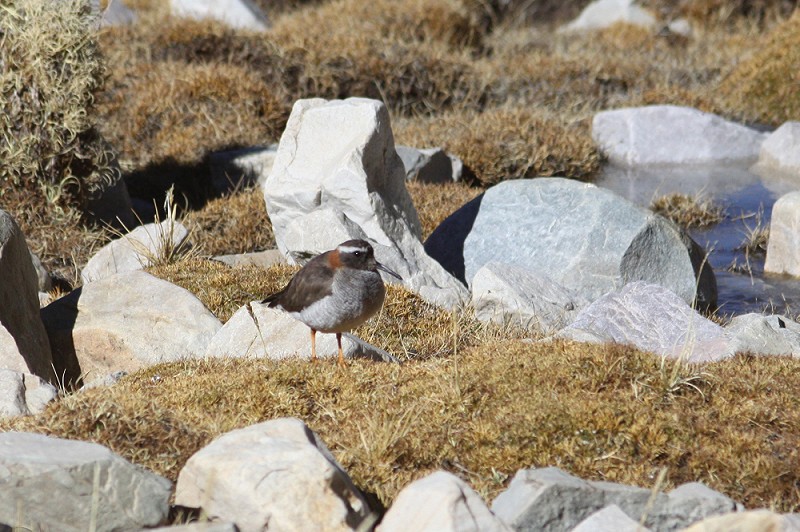 Diademed Sandpiper-plover Phegornis mitchellii (Ies Goedbloed)
Diademed Sandpiper-plover Phegornis mitchellii (Ies Goedbloed)
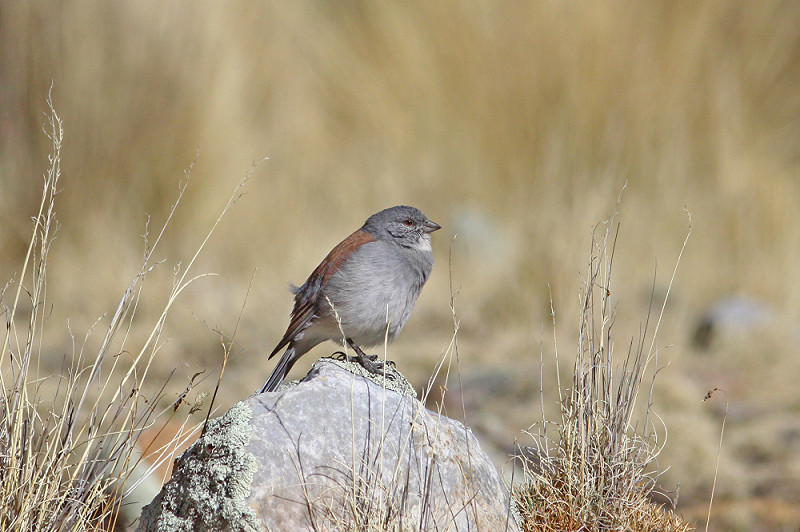 Red-backed Sierra-finch Phrygilus dorsalis (Ies Goedbloed)
Red-backed Sierra-finch Phrygilus dorsalis (Ies Goedbloed)
August 17th BIRDING THE PAMPAS GRASSLANDS
Last night I was picked up from the airport of Buenos Aires by Diego Monteleone and together we drove four hours south to the town of Lavalle, near the famous vagrant hotspot of Punta Rasa.
After just a couple of hours of sleep it was time to start birding! We started at Diego’s stakeout for the Hudson’s Canastero, his personal favourite pampas endemic. We quickly found this pampas counterpart of the puna Scribble-tailed Canaster, which I saw less than a week ago near Tucuman. Like last weeks’ Scribble-tailed-, the Hudson’s gave outstanding views. Another fantastic furnarid added to an already impressive year list of this family.
Next we drove a short distance to the grasslands of Palenque Farm and to our big surprise we found a flock of over a 100 summer-plumaged Rufous-chested Plovers! To make the wader bonanza complete, we found more than 30 Tawny-throated Dotterels and several Least Seadsnipes on the same field! Awesome stuff!
After checking out some classic pampas flocks of ducks, Black-necked Swans and Coscorobas we went after some furnarids again. Both Freckle-breasted Thornbird and Sulphur-bearded Spinetail were quickly taped out from their grassy hideout.
Punta Rasa itself proved rather uneventful, but the vunerable Olrog’s Gull – my main target – was easily found among the larger and more abundant Kelp Gulls.
I knew that Diego was the man to find the highly elusive Dot-winged Crake. A salt water marsh endemic which sound was unknown until Diego recorded it for the first time last year!
The grass looked dry and there was a strong wind, so chances of finding the crake were slim. But as Diego played the tape alongside a small salt water inlet, I suddenly saw something running our way, a crake! That must have been it! Luckily the bird came out again and showed for over a minute, an unforgettable sighting. Of course I’d forgotten my camera in the car, so all I could master was a blurry video still through my binoculars.
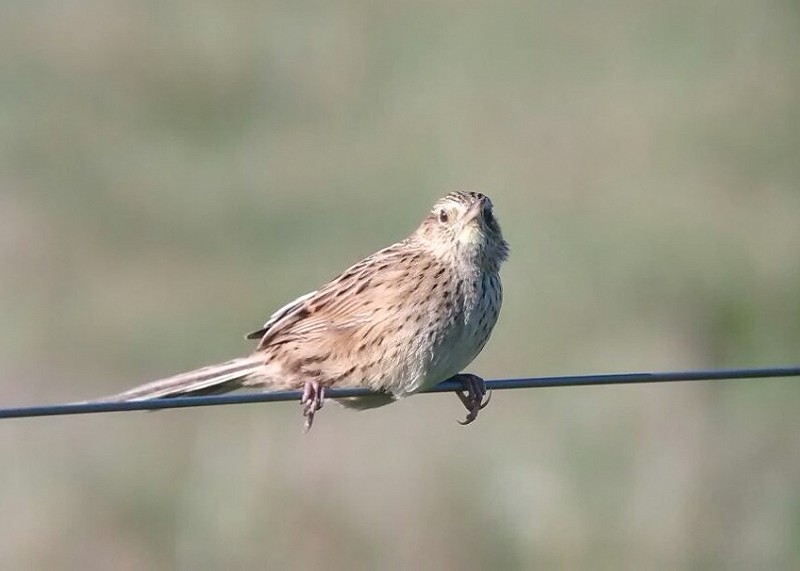
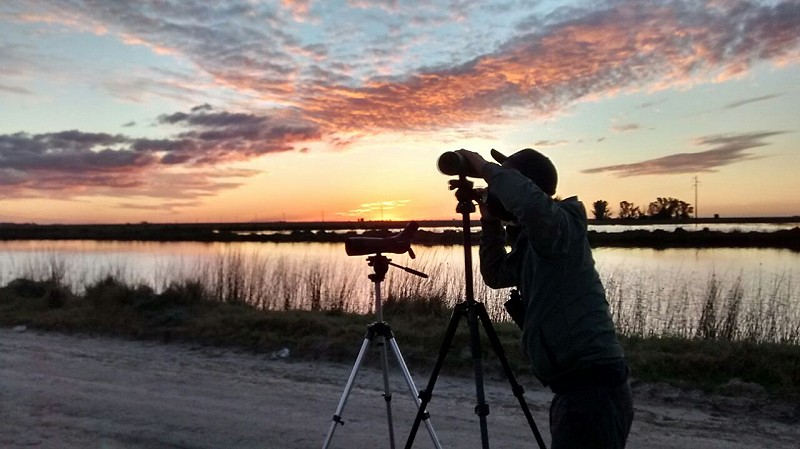
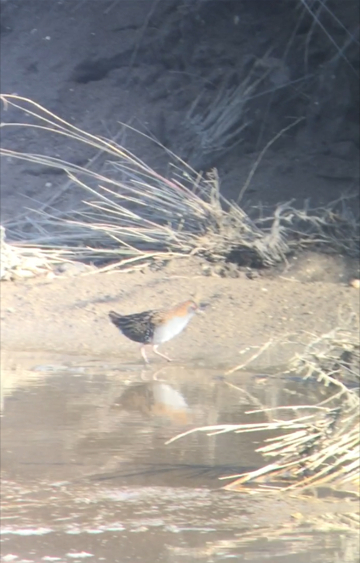 Dot-winged Crake Porzana spiloptera(Arjan Dwarshuis)
Dot-winged Crake Porzana spiloptera(Arjan Dwarshuis)
August 18th HUNTING THE REEDHAUNTER
After finding almost all of my targets yesterday – much faster than I held possible – my possibilities for today were limited to just a handful of new species.
Because around Punta Rasa only common Nearctic waders would mean new additions for my year, Diego and I decided to look for the localized Curve-billed Reedhaunter in a small reserve near Buenos Aires (there was simply no time to look for Straight-billed Reedhaunter north of Buenos Aires since I had to catch my 6 PM connecting flight to Punta Arenas… (but if I could have looked into the future…).
We arrived at this lovely small reserve – although looks can be deceiving cause most of the flora at this site is actually non-native – and after bagging my only other new possibility for today – Tufted Tit-spinetail – the search for the Reedhaunter began.
At a small patch of native reeds and scrub we rolled the tape hoping for the best and behold, out came the most cooperative Curve-billed Reedhaunter ever! A fantastic finish to my 15 days in Argentina!
In retrospect the Straight-billed Reedhaunter would have been possible too since my flight was cancelled, meaning that I had six hours to kill on Buenos Aires Airport…
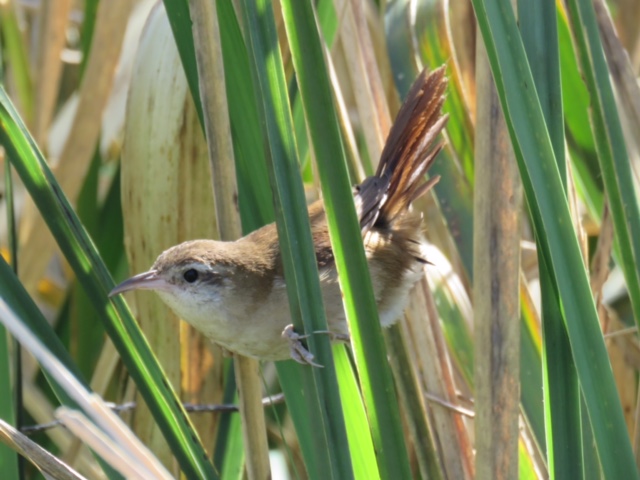
August 19th GOING FAR SOUTH!
Around 9 AM – just after sunrise – I touched down in Patagonia. Luckily my delay in Buenos Aires wouldn’t cost me any birding time 🙂.
An airport pickup sent by Far South Expeditions was already waiting for me and 20 minutes later I checked in at a hostel that overlooked the Magellanic Strait. I put my scope up on the balcony on the second floor for a short sea watch. This proved an excellent choice since there were unprecedented large numbers of Southern Fulmars foraging fairly close inshore, a species I did not expect to see at all this year! Other tubenoses were several dozens of Southern Giant Petrels, a couple of Black-browed Albatrosses, an unfortunately too far to identify Diomedea albatross and best, two Magellanic Diving-petrels.
At 2:30 PM I was picked up by Far South Expeditions top guide Sebastian Saiter and together we took a taxi to a small wetland at the eastside of Punta Arenas. The temperature was around zero and snow and ice was everywhere, what a change of scenery!
I got a great introduction to Patagonian birding with large numbers of Ashy-headed- and Upland Geese, Black-faced Ibisses and a totally unexpected Lesser Horned Owl!
Around the coastline birding was particularly great with large numbers of the exquisite Dolphin Gull and my first Rock- and Imperial Shags and Flying- and Fugean Steamer Ducks. In Patagonia there are not that many new birds for me to find, but about every bird is unique and very cool. Sebastian even told me that tomorrow I maybe have a chance to see Magellanic Plover…
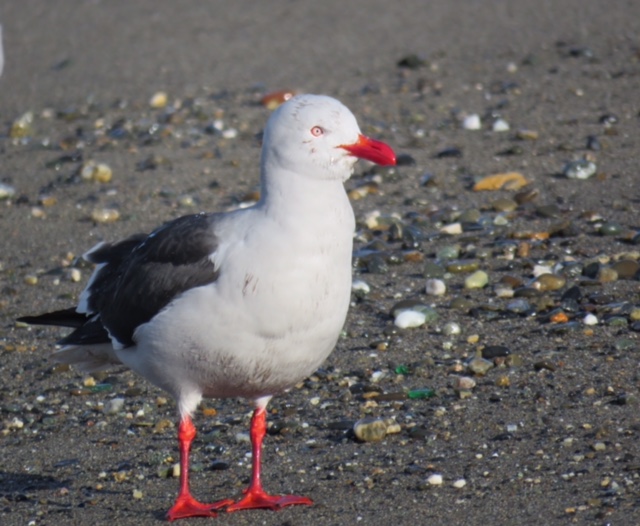
August 20th A TRIO OF VERY SPECIAL BIRDS
Far South Expeditions had kindly sponsored me a full day of birding with Sebastian Saiter around Punta Arenas. In the morning we were heading 60 kilometres southwest of town to look for Patagonian forest birds and in the afternoon we would travel 60 kilometres northeast of town to bird the Patagonian steppe. Normally this excellent single day tour is done in summer, but today we would prove that winter birding in Patagonia can be just as exciting!
As we drove west towards the Patagonian Forest we witnessed a breath-taking sunrise over the Magellanic Strait, it seemed like the entire horizon was on fire!
The first new birds for today were found along the windswept Patagonian coastline, Blackish Oystercatcher and Kelp Goose. Best was a pair of the monotypic Bronze-winged Ducks standing on an icy river.
As soon as we set foot in the beautiful Patagonian evergreen beach forest we heard the call of one of my most wanted birds, the huge Magellanic Woodpecker! Not long thereafter we were watching two females and a male of this beast-of-a-woodpecker foraging five meters away at eyelevel, magnificent!
Other great birds in the forest were Thorn-tailed Rajadito, Fire-eyed Diucon, Austral Parakeet and Magellanic Tapaculo.
As we were heading west again Sebastian suddenly yelled ‘stop’! Next to the car were three Ruddy-headed Geese! What a great find! This charismatic little goose is critically endangered on mainland South America due to predation from Grey Foxes, street dogs and habitat destruction. Luckily the population on the Falklands is still doing well, but a recent study shows that both populations may be considered separate subspecies.
In the afternoon we found ourselves on the windswept Patagonian steppe on the shore of huge icy lake, home of the Magellanic Plover. This very special wader was recently placed in its own monotypic family and for any birder visiting Patagonia it is one of the most wanted birds to find. I thought my chances in the middle of winter were very slim, but luckily Sebastian was optimistic!
The strategy to finding this awesome species is to slowly walk along the stony edge of the lake and scan ahead. After an hour of walking and seeing literally nothing I was beginning to loose hope. Then it happened, Sebatian suddenly froze, crouched down and pointed ahead of us. There was a family of White-bellied Seedsnipes, one of the most difficult to find birds in Patagonia! We watched these brilliant birds for half an hour foraging barely 10 meters from us and then we continued our search for the plover.
Barely five minutes later we saw two lonely waders standing at the lakeshore, could it be? Unbelievably enough there we two Magellanic Plovers! I couldn’t believe my eyes. We watched the birds for half an hour until my fingers started to freeze and my phone died of phone-scoping in the sub-zero temperature :). Stupidly enough I’d left my camera in the car so luckily I had my trusty Swarovski ATX65 telescope to film this magical moment! Thanks Vogelinformatiecentrum Texel and Swarovski for this fantastic equipment, I couldn’t have done it without you guys.
What an amazing day with Far South Expeditions! I can recommend any birder visiting Punta Arenas – winter of summer – to book this fantastic tour!
Arjan Dwarshuis
http://www.arjandwarshuis.com/#biggestyear
http://world.observation.org/arjan.php
PLEASE MAKE A DONATION NOW!
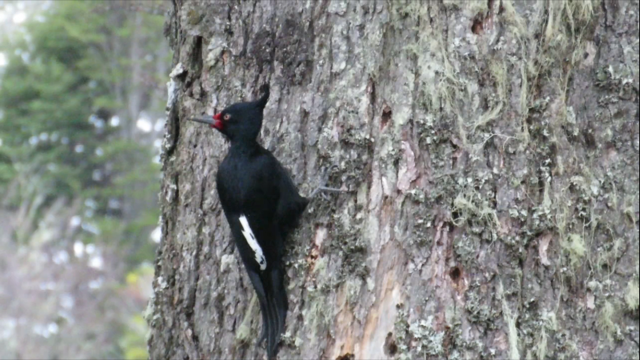
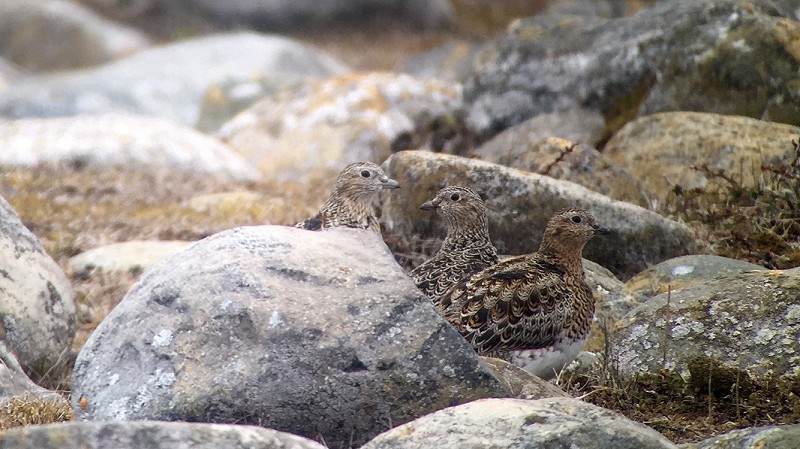
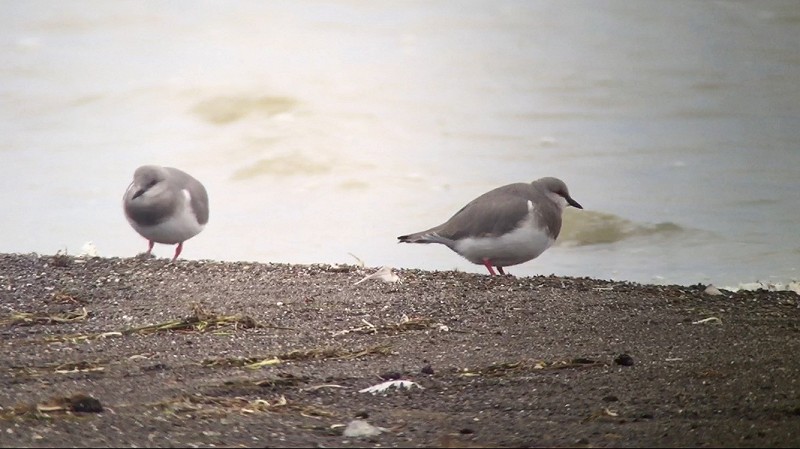 Magellanic Plovers Pluvianellus socialis(Arjan Dwarshuis)
Magellanic Plovers Pluvianellus socialis(Arjan Dwarshuis)
August 21st BEHAVING LIKE A REGULAR TOURIST
When I woke up this morning the weather was horrible, cold, grey with wet snow. Since there were next to zero possibilities anymore around Punta Arenas and since my flight would leave at 1 PM I decided that today I would do things like a regular tourist :). So for the first time this Biggest Year I returned to my bed, slept till 9 (!) AM, had a cup of coffee and some nice breakfast and enjoyed watching Southern Fulmars and Southern Giant Petrels with my scope from the comfort of hostel Entre Vienos’ living room. Indeed I should have flown to Santiago the evening before which would give me a day that I could have spent elsewhere, I guess that’s how the cookie crumbles, and you can’t think everything through to perfection…
After my flight to Santiago and a taking a taxi to my hostel I arrived just in time for a short stroll through the neighbourhood, after all I did not want to have another zero-day this year! However time was running out and the sun was already setting… Had I made a stupid mistake to take things so casually today? Just as I started having a panic attack – people were giving me weird faces as I frantically scanned every tree I could find with my binos, ‘I’m trying to break a record here people, give me a break’! – Suddenly I saw something reddish with wingbars fly past that landed on a tree in the garden next to me, could it be? Yes!!! Rufous-tailed Plantcutter, species number 4777! Dodged a bullet there :).
August 22th CRAG CHILIAS AND MOUSTACHED TURCAS
At 7 AM Fernando Diaz Segovia – the owner of Albatross Birding and Nature Tours and one of Chile’s top birders – picked me up for my full day looking for Chilean endemics in the mountains above Santiago. Fernando is involved in multiple conservation projects – Diademed Plover, Magellanic Plover and Markham’s Storm-petrel – throughout the country, so an honour to have him as my guide for the next couple of days.
It was slowly getting light as we drove up into the Andes (Santiago lays right at the base of the mountain range). The first bird on the agenda was a very cool endemic furnarid called the Crag Chilia. If you wonder about this name, Chilean birds are renowned for having excentric names. Only a little playback was necessary to persuade this bird to come in for a close look. While marvelling at the Crag Chilia we saw our first of many Moustached Turcas, a striking endemic tapaculo with an equally striking name.
After hauling in another fantastic tapaculo – the White-throated- we went in search for Chilean Tinamou and the endemic Dusky-tailed Canastero. Especially the Tinamou can be tricky sometimes so we were hoping to get that one out of the way as soon as possible. As we walked a small trail through a small canyon we found several Canastero’s and suddenly a Tinamou started calling. Fernando played some tape and the bird got a little closer and after one more try we saw this great bird making its way down the hillside.
For the afternoon we tried several wetlands near Santiago to look for the Salinas subspecies of Black Rail and to hopefully flush a South American Painted Snipe. We put on rubber boots and started our quest, but after 2 hours of walking and flushing dozens of South American Snipes we had to give up, we did hear the Rail – frustratingly close – and found a male Lake Duck.

August 23th TAPACULO FIESTA
We left Santiago early this morning and headed south towards the northernmost Patagonian forest in the beautiful Altos de Lircay NP. Our first stop was at a tiny patch of remaining lowland secondary forest along the highway, the absolutely northernmost limit of the distribution of Ochre-flanked Tapaculo.
As we stepped out of the car we heard another very cool Chilean specialty, the Des Mur’s Wiretail. Luckily these peculiar furnarids reminding of the Australian Emu-wrens are very inquisitive and moments later we had fantastic views. The Tapaculo required a bit more effort – people passing by on the highway looked in amazement at the two people crouched next to the road looking into roadside vegetation – but eventually I got exceptional views of this great skulker.
We arrived at Altos de Lircay NP at midday and started our search for two of the best Tapaculos in the world, the Chestnut-throated Huet-huet – another awesome onomatopoeic – and Chucao Tapaculo. Walking through this pristine nothofagus forest was an experience en sig with amazing viewpoints, big beautiful trees and bamboo and fern covered understory.
It took some time before we found the characteristic scratch-marks of a Huet-huet on the trail and after playing the tape we got an immediate response! Two birds started circling us calling continuously and after a tense wait we saw these superb birds crossing the trail, an amazing experience!
While we were busy with the Huet-huets a Chucao Tapaculo started calling and after climbing through some thick understory trying to get an angle I got some fantastic views! Great, both tapa’s were in the bag! To top things of we saw two new woodpeckers, Chilean Flicker and Striped Woodpecker and believe it or not, a 4th species of Tapaculo, a very showy Magellanic Tapaculo meaning we had seen four tapaculos of four different genera in a single day!
We stayed at the wonderful Hosteria De Vilches, a must visit when coming to this great NP! We were joined by one of the owners to look for Rufous-legged Owl, but even after two hours of trying at multiple locations the birds kept quiet…
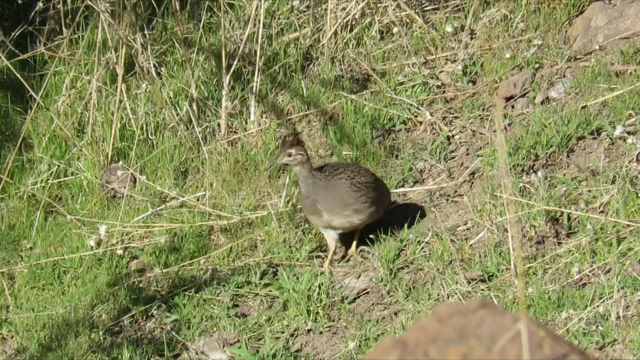
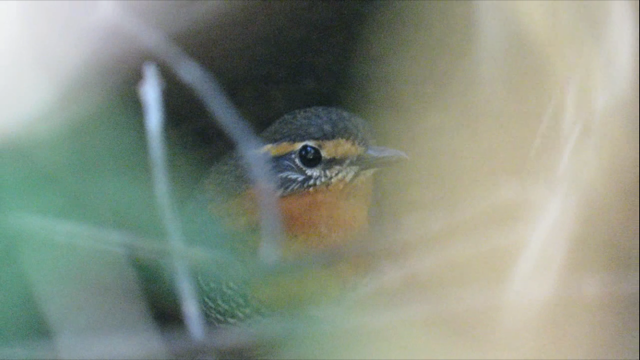
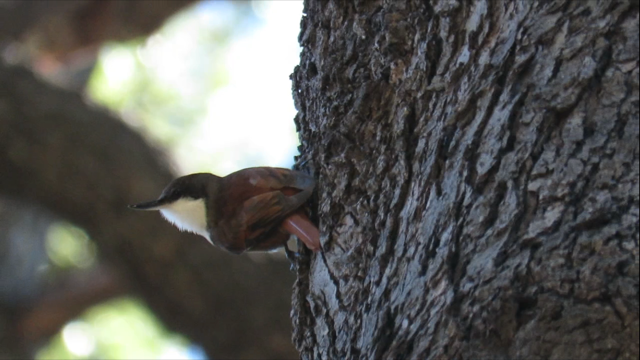
August 24th UP NORTH AGAIN
After trying once more for the owl without success, we drove north towards Santiago again. After six hours on the road – including two hours being stuck in Santiago traffic – we arrived at a small reserve an hour north of the capital. Our only target here was the Patagonian Forest Earthcreeper, an intriguing recently described species that winters here. Before we even got to the actual reserve one of these awesome birds flew across the road and posed for five memorable seconds before it disappeared forever. Great! We had little time on our hands so we decided to continue towards the coast.
Our first stop at the coast was at a Humbolt Penguin colony situated on a small island just of shore. There were dozens of Humbolt Penguins present, great to see since this species is declining throughout its range. A huge bonus was a single Magellanic Penguin, standing casually among its Humbolt cousins. A great catch-up after dipping this species in Patagonia. We found another endangered species in small numbers feeding offshore, the diminutive Peruvian Diving Petrel.
After finding the endemic Chilean Seaside Cinclodes it was time to head back to Santiago in order to escape traffic.
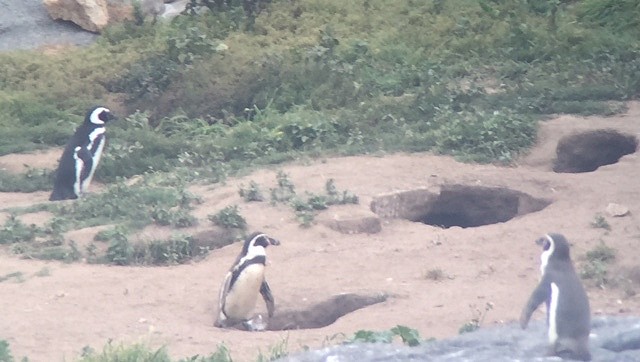
August 25th GOODBYE CHILE!
Already my last morning in Chile, I will surely come back to this beautiful country to take things on a more leisurely pace and enjoy the Patagonian forests and steppe in summer :). We left for the coast again to look for my last possible Central Chilean targets. At the parking lot a Dark-faced Ground-tyrant – an austral migrant – was a welcome bonus.
Like a couple of days earlier we put rubber boots on and walked the edge of a small wetland hoping to flush a South American Painted Snipe and like our previous attempt none were present. Well, I guess this elusive wader is another good reason to come back someday.
My last possible tapaculo – Dusky Tapaculo – this trip fortunately proved a lot easier to find and we had good views as the bird skulked circles around us, a typical behaviour for this family.
The best bird of the day was a Stripe-backed Bittern. We found this fantastic little heron in a small patch of reed along the road, behaving like our Little Bittern in Holland, very cool!
We ended this 3,5 day Central Chilean birding tour with a seawatch. Despite the fact that there was zero wind there were thousands of Sooty Shearwaters present offshore, but unfortunately no other newtubenoses. We did find a very welcome Chilean Skua preying on a Sooty Shearwater. We saw the bird hacking away at the shearwater trying to drown it, but after a five minute struggle the shearwater managed to escape unharmed. My last new bird in Chile were two beautiful Red-legged Cormorants flying by.
On to Peru!
August 26th ACROSS THE MIGHTY AMAZON
Last evening I had arrived at Lima airport where I met my girlfriend Camilla. Together we will travel for 28 days through every corner of Peru and Southern Ecuador. This mammoth birding trip covering every biome of the birdiest part of the world is made possible by Tanager Tours. Behind the scene former owner Wim ten Have has constructed the best possible itinerary and prepared all the logistics to the smallest detail. For the majority of the trip we will be guided by Miguel Lezama, a top birder and the new owner of Tanager Tours.
From Lima we flew straight to Iquitos where we would start this mega tour with a bang; three days of birding the varzea forest and river islands around the famous Muyuna Lodge and one day exploring the white sand forest of Allpahuayo Mishana Reserve.
After just a couple of hours of sleep – we’d arrived at our Iquitos hotel after midnight – we decided that it was time to do some birding before we would depart by boat to the Muyuna Lodge. For Camilla birding the Iquitos Boulevard was a great introduction to the birding extravaganza the Amazon is. In barely an hour we saw over 50 species, all of them of course lifers for her.
Around 10 AM we boarded our transfer to Muyana Lodge, more than 140 kilometres by boat across the mighty Amazon, quite an experience! During the last quieter stretch across a small tributary we saw both Scarlet-crowned Barbet and White-eared Jacamar. Around 1:30 PM we arrived at the lodge where we were greeted by Moises, the best local guide the lodge has to offer and half an hour later he took us on a boat upriver to look for the near endemic Black-tailed Antbird.
The shores of the river were very birdy and highlights includes a bright male Plum-throated Cotinga, Orange-fronted Plushcrown, Slate-coloured Hawk, Horned Screamer and a family group of the scarce Velvet-fronted Crackle. Best however was a very obligating pair of Black-tailed Antbird meaning that Camilla’s first ever Antbird was immediately a rare Peruvian specialty!
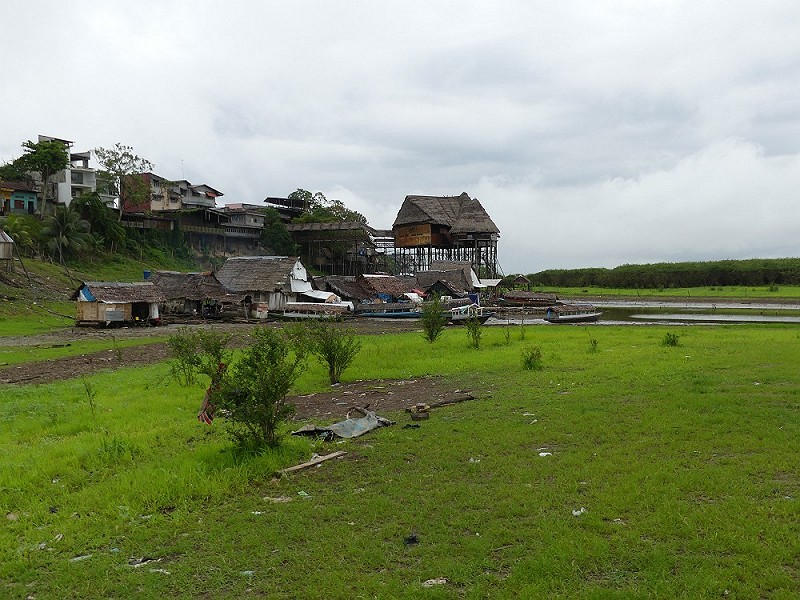 Amazonian village (Camilla Dreef)
Amazonian village (Camilla Dreef)
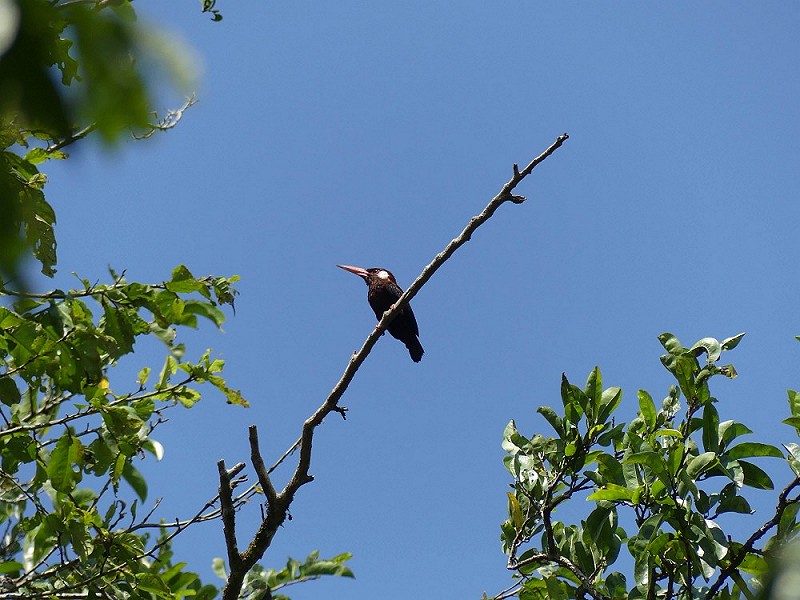 White-eared Jacamar Galbalcyrhynchus leucotis(Camilla Dreef)
White-eared Jacamar Galbalcyrhynchus leucotis(Camilla Dreef)
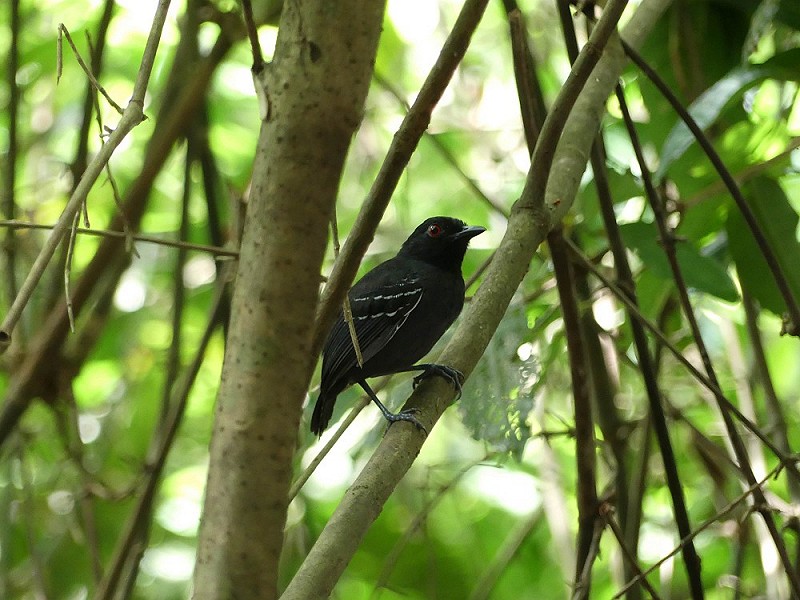 Black-tailed Antbird Myrmoborus melanurus (Arjan Dwarshuis)
Black-tailed Antbird Myrmoborus melanurus (Arjan Dwarshuis)
August 27th RIVER ISLAND SPECIALTIES
The main reason to visit the Muyuna Lodge from a Big Year perspective are the river island specialties, comprising about 20 fascinating species, which utilize the different niches – created by suggestion – found on these islands. To me the fact that there are 20 unique species only found on islands in the river embodies the glorious biodiversity of the Amazon.
As early as 4:30 AM Moises took us downriver on a small boat, en route we saw a huge Great Pootoo in the flashlight! At the crack of dawn we landed on a huge sandbank and from here we started walking. On the sandbank we found a nice selection of boreal waders on their way to their wintering grounds, most unexpected was a Buff-breasted Sandpiper.
As soon as we entered the grass and young secropia forest we started seeing river island specialties, four different spinetails, handsome Castelnau’s Antshrikes and Black-and-white Antbirds, the drab Olive-spotted Hummingbird and Lesser Hornero. The further we entered the tall older secropia forest we started seeing different birds namely Plain-breasted Piculet, Leaden Antwren and Ash-breasted Antbird, but the best find was a pair of the poorly known Zimmer’s Woodcreeper, for me that is, Camilla was more occupied with a stunning Great Pootoo roosting in a tree on the other side of the trail.
We found two beautiful Parrot species, the Short-tailed- and the gaudy Festive Parrot and after tracking down Pale-billed Hornero and Pearly-breasted Conebill we had completed our quest!
Back on the boat we had a late brunch that was put on a hold when a pod of Pink River Dolphins popped up right next to the boat, an amazing sighting! We even saw several of them breaching!
After lunch and a well-deserved cold shower and powernap – it gets very hot on a river island – we did a loop on the trail system behind the lodge to look for a true Muyuna specialty, the Rufous-necked Puffbird. We walked silently for hours following Moises through a mosquito infested varzea forest, but there was no sign of the puffbird. We did see several tiny Pygmy Marmosets and a fantastic Wire-tailed Manakin. We were already heading back to the lodge when the sun had nearly set when Moises suddenly froze and pointed to a plump shape sitting on a low branch, the Puffbird, a fantastic pair to be precise! What a great day!
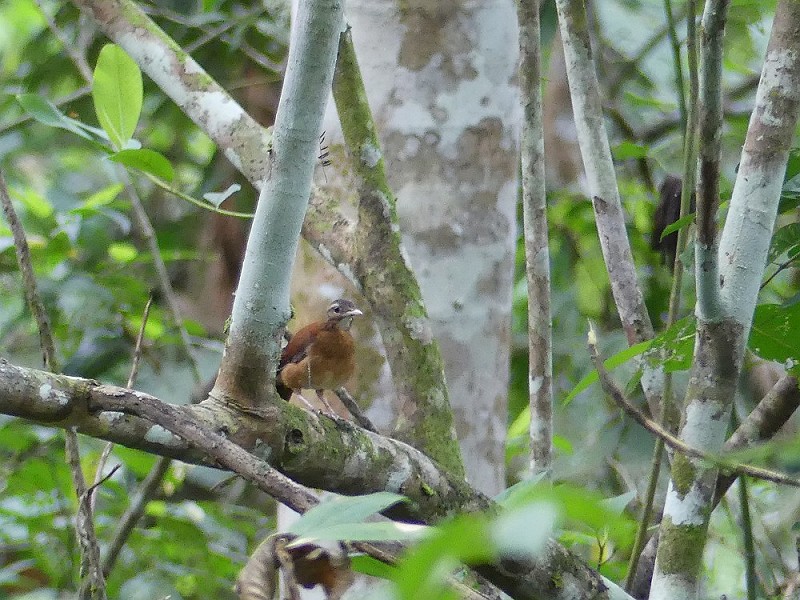 Pale-billed Hornero Furnarius torridus(Camilla Dreef)
Pale-billed Hornero Furnarius torridus(Camilla Dreef)
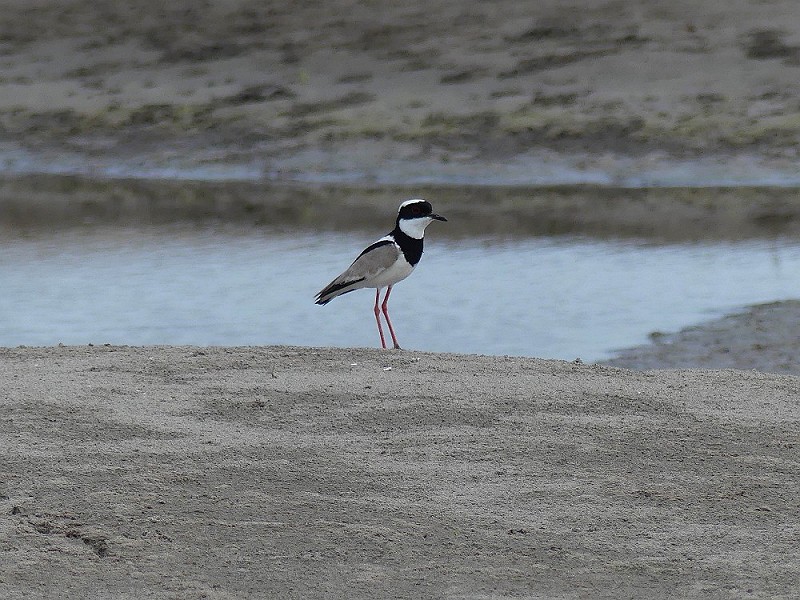 Pied Lapwing Vanellus cayanus (Arjan Dwarshuis)
Pied Lapwing Vanellus cayanus (Arjan Dwarshuis)
August 28th TRACKING THE WATTLED CURASSOW
There is one Holy Grail for every serious birdwatcher visiting the Muyuna Lodge, the incredibly rare and endangered Wattled Curassow. This amazing game bird has been driven to the brink of extinction by habitat destruction, but mainly through hunting and capture for the pet trade. The largest known population is found in remote varzea forest in a protected area near the Muyuna Lodge – Muyuna actually means Curassow! Finding this mythical bird is extremely difficult, you have to be in the forest before sunrise, the birds are terribly shy and of course they are far from common.
When it was still dark we left Muyuna lodge by boat and half an hour later we started walking along the edge of a small vegetated oxbow lake. We followed Moises in complete silence while he skilfully made his way through the forest undergrowth with a machete. After two hours we still hadn’t seen let alone heard a Curassow, but luckily there were several noisy Horned Screamers to keep us busy. Suddenly a big bird flew up from the forest floor and Moises whispered ‘curassow’! Had we blown our only chance at the beast? But there flew two more birds away from and by some miracle I saw one landing 200 meters away through a key-hole in the forest canopy. I aimed the scope and for 1 magical minute we had fantastic views of a Wattled Curassow! A moment we shall not soon forget.
After this thrilling morning we took a leisurely walk to a family of prehistoric looking Hoatzins, fantastic birds placed in their own monotypic family. Another good find was a noisy and showy Varzea Schiffornis.
We had already our last lunch at the fantastic Muyuna Lodge and boarded our fast boat 140 kilometers across the Amazon back to Iquitos, but not before we saw – the same? – pod of Pink River Dolphins one more time :).
August 29th THE WHITE SAND FOREST OF ALLPAHUAYO MISHANA
Early morning Camilla and I took a collectivo to km 25 along the road from Iquitos to Nauta, from here one can access the Allpahuayo Mishana Reserve. This protected area harbours a nice track of white sand forest – a peculiar type of stunted forest that grows on poorly drained sandy soils – from where almost two decades ago no less than five new species for science where described, the Allpahuayo Antbird, Zimmer’s Antbird, Ancient Antwren, Mishana Tyrannulet and Iquitos Gnatcatcher. Ten years ago I spent 12 days in Iquitos and visited this reserve more than eight times before I’d finally seen all these specialties. Especially the critically endangered Iquitos Gnatcatcher is incredibly difficult. Allpahuya Mishana is well known as being one of the quietest places in the Amazon and despite the amazing bird list you are bound to find only a tiny percentage.
Just after we entered the white sand forest there was some activity which resulted in great sightings of Ancient Antwren, Pearly Antshrike and Citron-bellied Atilla, but quickly as it started bird activity dropped to almost zero before 8 AM. This resulted in me getting very frustrated by 10 AM. Still none of the antbirds and a lot of other specialties were missing.
We redeemed ourselves in the late morning with two sightings of the uncommon Many-banded Aracari, a Yellow-billed Nunbird and a Mishana Tyrannulet, but no Gnatcatcher or Antbirds were found.
We took a collective back to Iquitos, had lunch and went to the airport for our flight to Lima. Iquitos was great despite a rather disappointing Allpahuayo, but that’s just how this place works 🙂
Arjan Dwarshuis
http://www.arjandwarshuis.com/#biggestyear
http://world.observation.org/arjan.php
PLEASE MAKE A DONATION NOW!
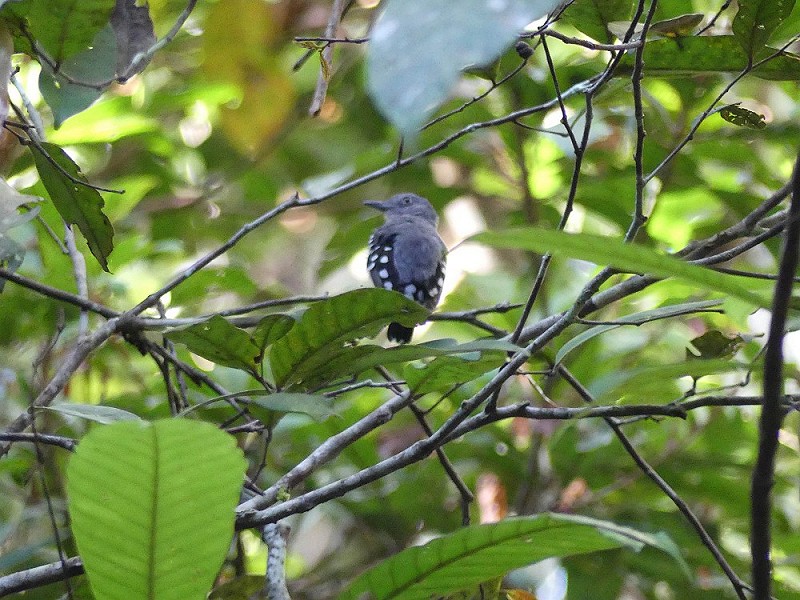 Pearly Antshrike Megastictus margaritatus (Camilla Dreef)
Pearly Antshrike Megastictus margaritatus (Camilla Dreef)
August 30th A DAY IN THE DESERT
Last night we had arrived at Lima Airport where we were picked up by fellow Dutchman Wim ten Have. Wim is the founder and the former owner of Tanager Tours and now lives with his wife 20 kilometres north of Lima. It was nice seeing Wim again after 15 years, he was joyful as always and still smoked like a chimney 🙂. My dad and I had such a great time with him visiting the Manu Road, Amazonia and Pantiacolla Lodge 15 years ago. Lots of good memories!
After spending a short night in a hotel with a rather strange taste when it comes to decoration – paintings of sad clowns, naked cupids 🙂 – we left for Lomas de Lachay, an hour drive north of Lima.
Around the cactus-dominated hillsides near this site we went in search for two endemics, the Cactus Canastero and Thick-billed Miner. It took us a solid two hours of searching before we finally managed to connect with both these species. Of course we found the Catus Canastero singing away from its home, a cactus. After this success we drove to the other side of the reserve – the official entrance – were we looked for Peruvian Meadowlark.
For our last location we visited a small coastal wetland two hours north of Lima. At this site Wim had seen the rare and endangered Peruvian Tern several times before. When we arrived at the wetland it was teeming with birds, clearly large numbers of northern waders had just arrived at their wintering ground! We found no less then 15 species of waders, most of them extreme rarities back home in the Netherlands. Best however were 4 Peruvian Terns feeding above the lake, fantastic!
After dragging us away from this wader paradise we headed back to Lima to catch our evening flight to Juliaca airport, situated at 3900 meters altitude in the south-eastern Andes of Peru. Here we were met by Miguel Lezama – the owner of Tanager Tours and one of the absolute top birders in Peru – and Juvenal CCahuana – long term driver for Tanager Tours and local bird expert. Together we will be birding for the next 2,5 weeks in every corner of Peru.
August 31st ME AND MY ALTITUDE SICKNESS…
When I woke up this morning I knew it was going to be a tough day since I’ve had bad experiences with birding at high altitude before, especially when going up straight from sea-level to above 4000 meters. And we were going for 4500 meters to look for White-throated Sierra-finch!
I felt miserable – nausea and headache – when we arrived at Miguel’s Sierra-finch stakeout, but luckily the scenery was spectacular and Miguel was already hot on the trail of the Sierra-finch while I was still trying to stand on both feet without vomiting all over the place :).
Suddenly Miguel called in the Sierra-finch on the walky talky from 300 meters away, argh! How was I going to make it there? Luckily I had my scope and after some directions through the walky-talky I had both birds in view, great! Another good bird at this site was Black-fronted Ground-tyrant, a rare austral migrant to Peru.
When we arrived at Lago Titicaca – at 3800 meters – I already felt a lot better, especially after we found a pair of the endangered and flightless Titicaca Grebe. This special bird is unfortunately suffering from pollution and ongoing development along the lakeshore and becomes harder to find every year.
From Puno we drove towards Cuzco where we would spend the night. Several stops en route resulted in Dark-winged Canastero and Darwin’s Nothura. Tomorrow we will be birding on the Manu Road!
September 1st FROM THE DRY WEST SLOPE TO THE MANU CLOUD FORESTS
We started our day at the edge of Huacarpay Lake near Cuzco. Our main target here was the endemic and beautiful Bearded Mountaineer, one of Peru’s most special hummingbirds. The search didn’t take us long since the first bird we saw was the Mountaineer feeding on some exotic flowers. While having breakfast at the edge of the lake Miguel taped in another endemic, the Chestnut-fronted Canastero.
From Huacarpay Lake we travelled up towards the Manu Road, arguably the best birding site in the entire world. En route we picked up another nice endemic, the dazzling Chestnut-breasted Mountain-finch.
What is so great about the Manu Road is that here you can find all the east slope habitat zones from the wet paramo grassland all the way to the lowland Amazon Basin. Not only that, it is one near-continuous stretch of primary forest so you can experience the transition and diversity of bird species like no other place in the world.
The birding fiesta started immediately at the edge of the first elfin forest patch, Cream-crested Spinetail and Puna Thistletail, two nice furnarids were both quickly found.
As we slowly travelled down we encountered one mixed flock after another and the further we got down the larger and more diverse these flocks got. Dazzling Grass-green-, Scarlet-bellied Mountain- and the rare Golden-collared Tanager were mixing with White-collared Jays, a show one has to see to believe.
At the end of the day we positioned ourselves in a nice patch of bamboo and played some tape, this resulted in incredible views of both Rusty-breasted- and the endemic Red-and-white Antpitta.
After this spectacle we checked in at the wonderful Wayquecha Biological Station. This amazing lodge in the middle of the cloud forest is unique in many ways. First and foremost all the income from tourists staying there goes directly to conservation, education and scholarships for biologists and ecologists. The Amazon Conservation Association now has three lodges like this and all take part in this pioneering approach to conservation. In doing so they’ve developed a concept that is applicable all over the world.
We ended this great day like many other great days this year, with a stunning rare owl, the Rufous-banded Owl!
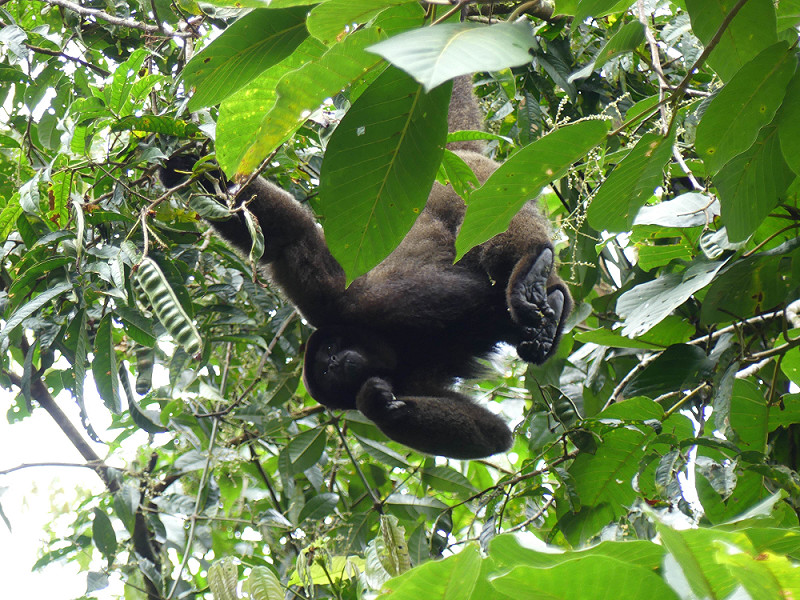 Brown Woolly Monkey Lagothrix lagotricha (Arjan Dwarshuis)
Brown Woolly Monkey Lagothrix lagotricha (Arjan Dwarshuis)
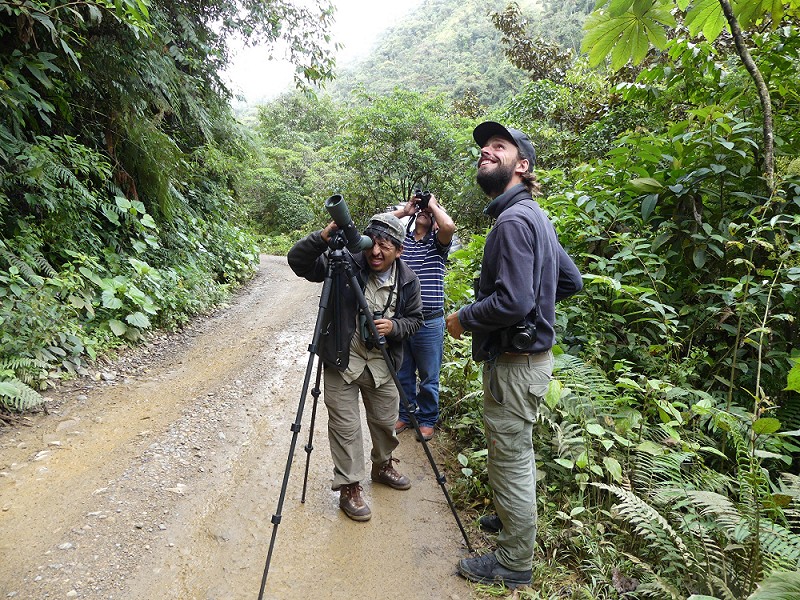 Birding the Manu Road (Camilla Dreef)
Birding the Manu Road (Camilla Dreef)
September 2nd THE MOST CRAZY DAY OF MY YEAR SO FAR
When your day starts with displaying Swallow-tailed Nightjars right over your head and you end that same day with a singing Lyre-tailed Nightjar perched in the scope, then you know it’s a mental day regardless. All the things we saw in between these two fantastic night birds will blow your mind… I can still hardly believe the complete mayhem of birdlife we encountered.
Ok, long story short I saw more than 70 (!) new birds for my Biggest Year, among them many rare and most wanted enigmas.
After the nightjar and breakfast – while looking down over continues cloud forest stretching down all the way to the Madre de Dios river, 2500 meters below us – we started roadside birding down the legendary Manu Road. Flocks were lurking around every corner. Every hundred meters or so we had to stop to scan through a bird-wave. Besides countless different tanager and hummingbird species we saw both Grey-breasted Mountain- and Blue-banded Toucanet, the range-restricted Fulvous Wren and the endemic Marcapata Spinetail.
Two undoubted highlights of the day came in relatively quick succession, a beautiful Chestnut-crested Cotinga perched next to the road and a pair of Solitary Eagles, displaying over the forested hillside thereby grabbing each other’s talons and tumbling down from the sky.
Further down as we left the elfin forest and entered the cloud forest we encountered a whole new set of birds. Incredibly beautiful and adequately named Versicoloured Barbets, gaudy Golden-headed Quetzals and a pair of the rare Crimson-bellied Woodpecker had to fight for attention with huge flocks of tanagers. And this went on and on throughout the day and before we knew it we had entered the home of the amazing Andean Cock-of-the-Rock. We visited a lek of this most iconic Andean bird. A show that simply blows your mind.
And I almost forgot about Andean Motmot, White-capped Dipper and a roosting Andean Potoo. Like I mentioned earlier this day was just off the chain. And yes we finished with a displaying Lyre-tailed Nightjar, as if it wasn’t good enough yet :).
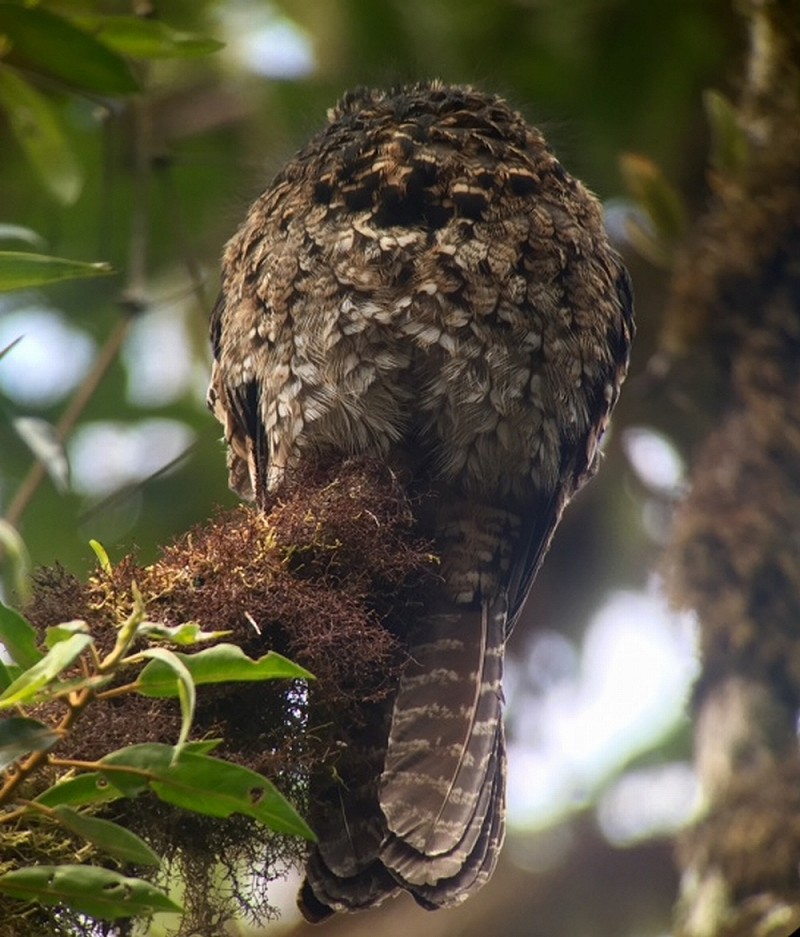 Andean Potoo Nyctibius maculosus (Arjan Dwarshuis)
Andean Potoo Nyctibius maculosus (Arjan Dwarshuis)
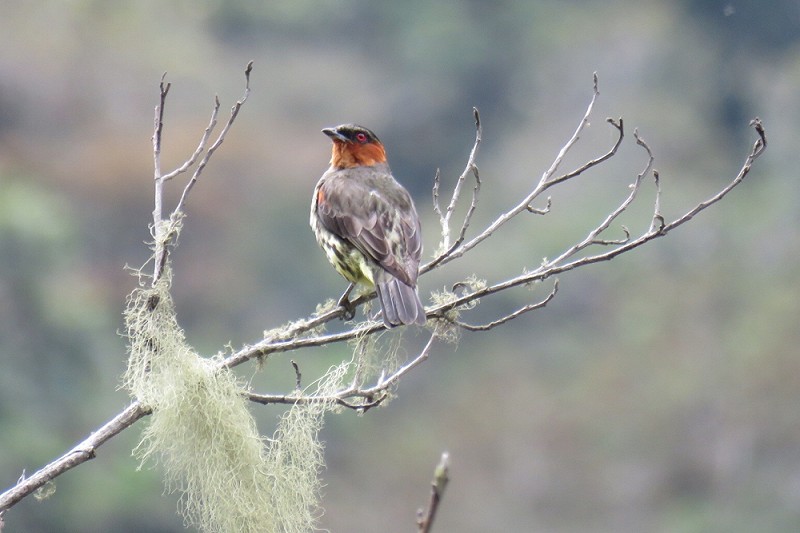 Chestnut-crested Cotinga Ampelion rufaxilla (Arjan Dwarshuis)
Chestnut-crested Cotinga Ampelion rufaxilla (Arjan Dwarshuis)
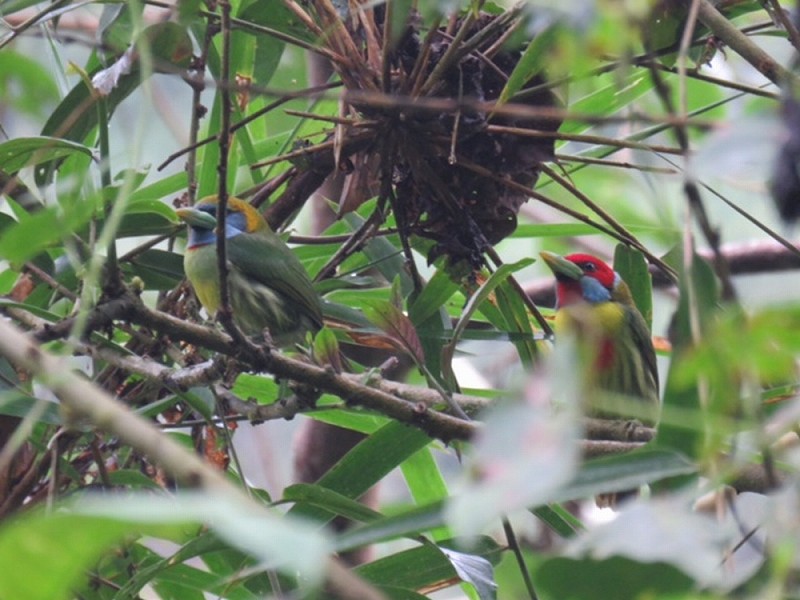 Versicoloured Barbet Eubucco versicolor (Arjan Dwarshuis)
Versicoloured Barbet Eubucco versicolor (Arjan Dwarshuis)
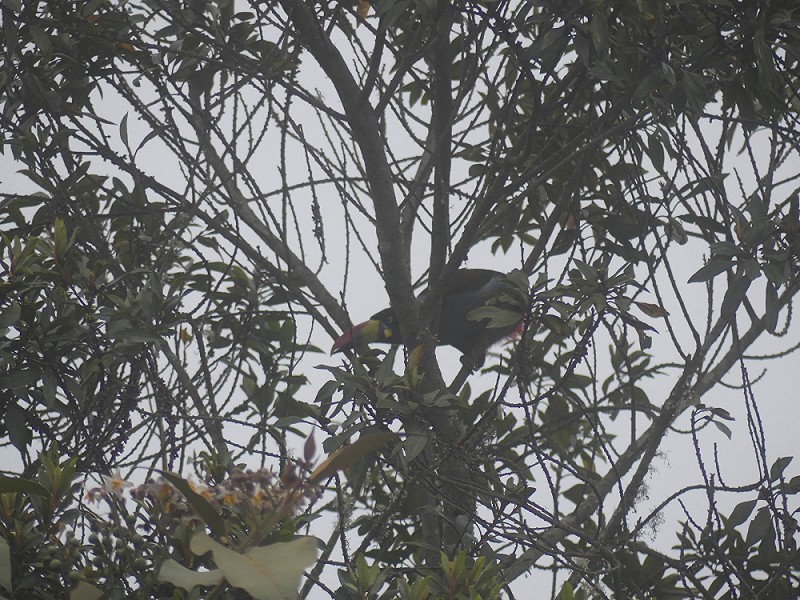 Grey-breasted Mountain-toucan Andigena hypoglauca (Arjan Dwarshuis)
Grey-breasted Mountain-toucan Andigena hypoglauca (Arjan Dwarshuis)
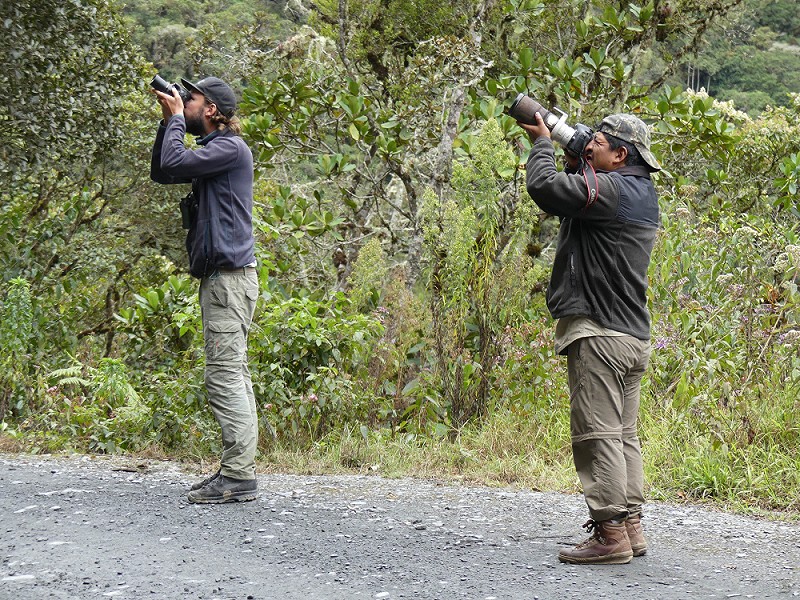 Birding the Manu Road (Camilla Dreef)
Birding the Manu Road (Camilla Dreef)
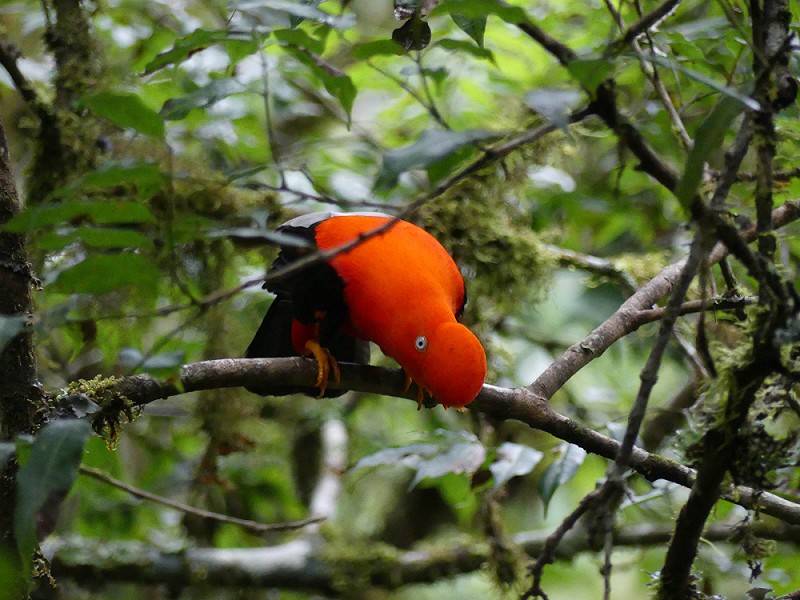 Andean Cock-of-the-rock Rupicola peruvianus (Camilla Dreef)
Andean Cock-of-the-rock Rupicola peruvianus (Camilla Dreef)
September 3rd THE BAMBOO FOREST OF VILLA CARMEN
Last evening we had arrived at Villa Carmen, a lodge and biological station initiated by the same organization as Wayquecha Biological Station, the Amazon Conservation Association. At this amazing place they are experimenting with new forms of sustainable land use, in doing so they hope to offer an alternative to the ‘slash-and-burn’ agriculture that is responsible for so much deforestation. Like Wayquecha all the income from tourism goes directly to conservation, education and scholarships for biologists and ecologists.
While having breakfast at 5 AM Miguel came with fantastic news. Apparently there is some very good spiny bamboo forest to be found at Villa Carmen and all the bamboo specialists can be found here. Great! I had not expected to get any chance on finding this specialties this year and the only possible location would have been at least a day traveling back and forward from Puerto Maldonado. Naturally we decided on spending the entire morning tracking down these specialties.
Shortly after entering the excellent trail system we entered the bamboo forest and after several hours we had found White-lined Antbird, Dot-winged Antwren, Bamboo Antshrike, Bamboo Foliage-gleaner, Flammulated Bamboo-tyrant, Goeldi’s Antbird and best the beautiful White-cheeked Tody-tyrant and the iconic Manu Antbird.
Later in the morning things got even more interesting with excellent views of Amazonian Antpitta, Rufous-capped Nunlet and a stunning Rufous-breasted Piculet.
After a great lunch and an inspirational talk with Jeff Woodman – one of the board members of the Amazon Conservation Association – we hit the trails again, but around 4 it began to rain heavily so we had to aboard our afternoon birding session.
September 4th BACK UP THE MANU ROAD
Miguel had made an excellent plan of attack for the morning. We would make one more swoop through the bamboo forest to look for Striated Antbird and afterwards bird till 9 AM in the secondary forest to look for Fine-barred Piculet. After half an hour on the trail Miguel heard a Striated Antbird and we managed to get good looks at the bird. The piculet took some more time, but after some persuasion we found a pair of this near endemic. The most unexpected and most awesome sighting of the morning however, was a group of 4 Razor-billed Curassows walking in the middle of the trail!
After saying goodbye to all the staff at Villa Carmen – you guys were great and Camilla and I will certainly come back in the future – we travelled back up the Manu Road. At the bamboo forest at the lowest part of the Manu Road we made a stop to look for two endemics, the Black-backed Tody-flycatcher and Peruvian Piedtail which we both found quickly.
A little bit higher up – at the transition from sub-montane forest to cloud forest – we found several other specialties like Cinnamon-faced Tyrannulet, Golden-collared Honeycreeper, Grey-mantled Wren and a very showy Chestnut-tipped Toucanet. On one of Miguel’s secret stakeouts we found an unbelievably showy Slaty Gnateater and moments later we were treated to a calling male Crested Quetzal! Our best find however was a Black-streaked Puffbird, which Miguel brilliantly found on call!
From hereon we travelled all the way up to the treeline – picking up another Grey-breasted Mountain-toucan, a Yungas Pygmy-owl and a Golden-browed Chat-tyrant along the way – and from there all the way to Urubamba where we spend the night at Miguel’s parents’ place. So kind of them to let us crash and they’d even prepared dinner for us! Tomorrow we will chase Peruvian endemics around the famous Abra Malaga pass!
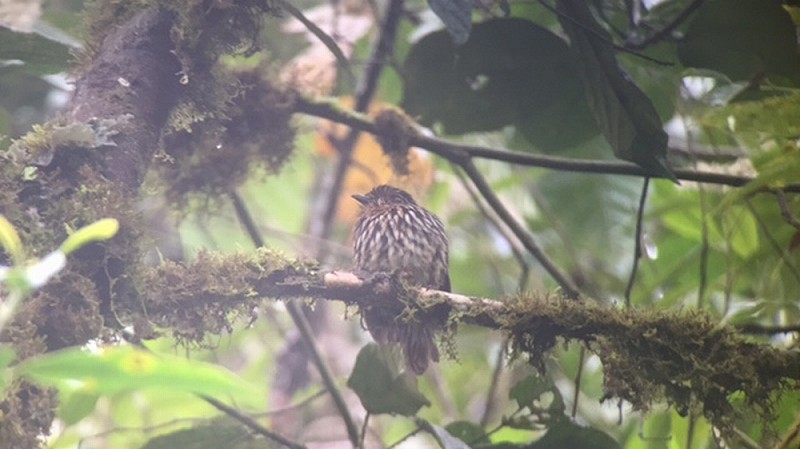 Black-streaked Puffbird Malacoptila fulvogularis(Arjan Dwarshuis)
Black-streaked Puffbird Malacoptila fulvogularis(Arjan Dwarshuis)
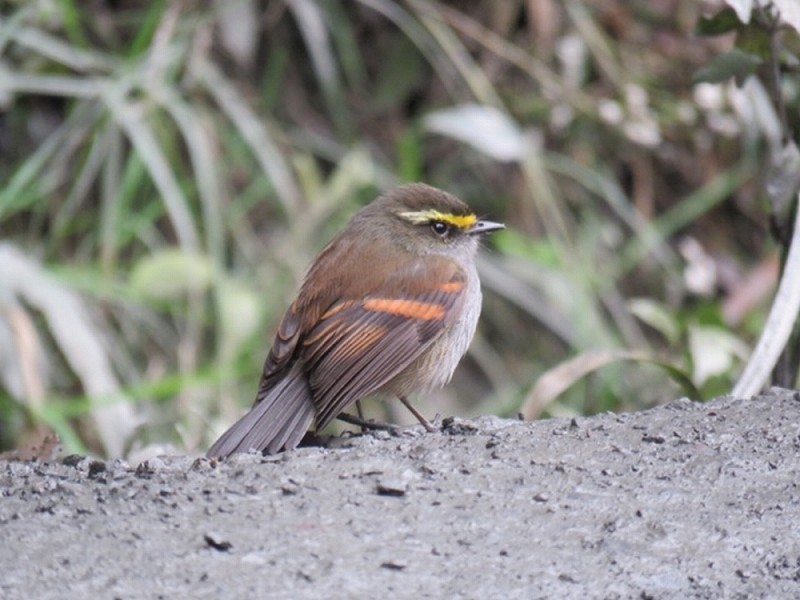 Golden-browed Chat-Tyrant Silvicultrix pulchella(Arjan Dwarshuis)
Golden-browed Chat-Tyrant Silvicultrix pulchella(Arjan Dwarshuis)
September 5th RARITIES OF ABRA MALAGA
Today we would search for one of the rarest and most sought after birds in Peru, the critically endangered Royal Cinclodes. This spectacular furnarid has suffered tremendously from logging of polylepis forest for use of firewood. Polylepis forest is a peculiar type of stunted forest that is only found above 4000 meters in the Andes. Besides the Royal Cinclodes it provides home for a very specialized bird community that includes several rare and endangered species.
Before we would visit the polylepis forest above Abra Malaga pass however, we would first have to track down a couple of endemics in the elfin forest on the east slope of the pass. En Route we picked up Puna Tapaculo and the endemic Junin Canastero in the dry scrub on the west side of the pass.
We were highly successful in the elfin forest and within 2 hours’ time we found all our targets: the endemic Inca Wren, Cuzco Brush-finch, Parodi’s Hemispingus, Tit-like Dacnis, Plushcap, Unstreaked Tit-tyrant, Diademed Tapaculo, Scaled Metaltail and the local form of Rufous Antpitta.
From here we drove up again to the pass and from there we went on foot, up the pass and down into the valley on the other side were the polylepis pockets are found. We would walk all the way down to the bottom of the valley where Juve would pick us up again. Besides the spectacular birds the scenery is truly breath-taking; in the literal sense of the word since the polylepis lies at 4300 meters!
We started off on the same pace as in the elfin forest with a small flock containing Ash-breasted Tit-tyrant, Giant Conebill, Tawny Tit-spinetail and the endangered White-browed Tit-spinetail. Meanwhile Stripe-headed Antpitta’s were calling from the valley below us. Red-rumped Bush-tyrant was also quickly located.
Now there was only the Royal Cinclodes… We waited for half an hour or so, now and then playing some sound. Suddenly there was a movement in the understoy of the polylepis and moments later we had brief, but smashing views of a Royal Cinclodes! Mission accomplished.
After teaming-up again with Juve down in the valley we drove down towards Mollepata. En route we picked up two endemic hummingbirds, the White-tufted Sunbeam and the Green-and-white Hummingbird, the latter with a backdrop of the spectacular Ollaytaytambo Inca ruins.
Just before dark we tried for the endemic Pale-tailed Canastero, but we got no response. Much more unexpected however was a calling Taczanowski’s Tinamou! We tried to get closer and got to within 20 meters of the bird, but then it stopped calling… damn…
Amazing days usually end with an amazing night bird and this day was no exception on that rule. A stunning pair of the little known Koepcke’s Screech-owl was the icing on the cake that night.
September 6th APURIMAC ENDEMICS
We had a long travel day ahead of us, from Mollepata we had to get all the way to the Andean town of Puquio, half way between Mollepata and Lima. First however we would look for some endemics of the Apurimac Valley above the town of Mollepata.
We started with the adequately named Apurimac Spinetail and Apurimac Brush-finch, both were quickly found while having breakfast at Miguel’s stakeout for these two species.
After breakfast we drove up to the treeline were we searched – with success – for the highly localized Vilcabamba Tapaculo.
Now it was time to commence with our long drive down into the inter-montane Apurimac valley and up again into the high Andes, but not before we found the rare ushueri race of the endemic Pale-tailed Canastero in its dry scrubby home.
There was one more surprise waiting for us… during a lunch stop at the top of the Apurimac valley Miguel played some sound of the yet-to-be-formerly-described ‘Apurimac’ Tapaculo and to our amazement one immediately gave a response! For half an hour we tried to get a view of the bird, but it proved extremely elusive, we had to settle with brief skulking views of this enigma.
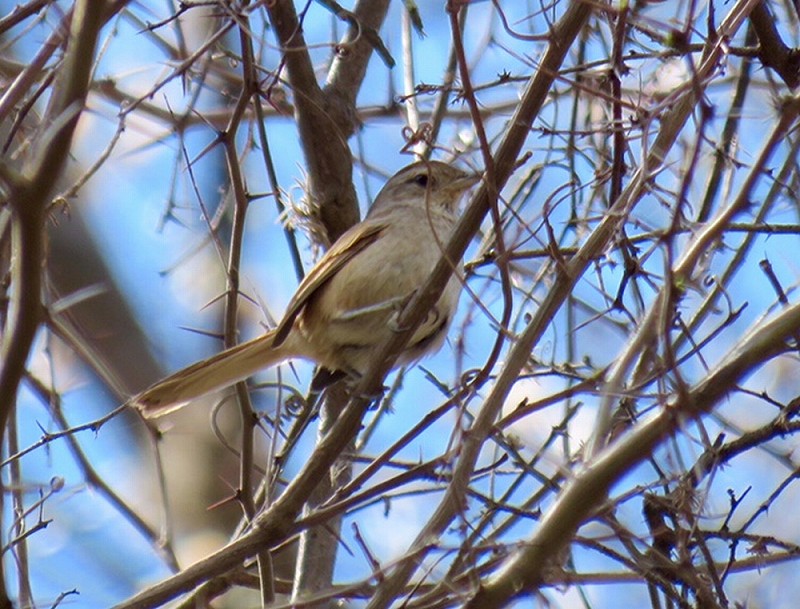 Pale-tailed Canastero Asthenes huancavelicae(Arjan Dwarshuis)
Pale-tailed Canastero Asthenes huancavelicae(Arjan Dwarshuis)
September 7th A HUGE SURPRISE EN ROUTE TO LIMA
We left Puquio at 4:30 AM since we had a 700 kilometre drive to Lima ahead of us – enormous respect for Juve for tackling such distances behind the wheel without even blinking.
Again we had a couple of planned stops en route. The first one was at a dry forested river bed below the city of Nasca – yes, we ‘twiched’ the famous Nasca lines from a small lookout tower along the highway :). Our target here was the vulnerable Slender-billed Finch which we found foraging alongside Parrot-billed- and Drab Seedeaters.
As we drove further through the Atacama Desert to the coast I suddenly spotted a couple of martins flying next to the road. We stopped and to our amazement we found out that they were Peruvian Martins, at least 20 birds! Luckily Miguel was able to take some pictures of these rare and poorly known birds as they migrated north through the desert. This is a significant record illustrating that these birds must have their wintering grounds somewhere further south in the desert – maybe the border region with Chile? Anyhow a huge bonus!
Our last stop was at the coastal fishing village of El Poqueron. Here we found the endemic Peruvian Seaside Cinclodes and several Humbolt Penguins and breeding Inca Terns and Red-legged Cormorants – resulting in a very happy Camilla!
We spent the night at Wim ten Have’s home 20 kilometres north of Lima. Tomorrow we will start with our swoop through the endemic-packed central part of Peru!
September 8th MISSION IMPOSSIBLE
Miguel had something outrageous in mind, to do the Santa Eulalia Valley and Marcapomacocha in a single day and still make it in time to Junin to spend the night there. This would mean that we had to drive up from sea-level (Wim’s house) to 4800 meters (Marcapomacocha). The last time I did something similar I was vomiting and simultaneously crying while being dragged by my friend Vincent to a scope to see a Diademed Plover :). I guess you can say I’m quit subjective to altitude sickness. Luckily Camilla has altitude sickness pills with her so I hoped for the best…
Our first target right after sunrise was the Great Inca-finch, but after half an hour of searching we had to give up and drive up to try for one of the trickiest birds today, the endangered Rufous-breasted Warbling-finch. We tried for two hours along the famous stretch of road where the bird is sometimes recorded, but had no success. I had already given up by 10 AM, but Miguel kept pushing, we had to find this bird! Suddenly I heard a whistle, Miguel had found the bird! I took a sprint, but when I arrived the bird was gone. It took us another half an hour before I finally re-found the bird. Awesome, but we had lost a lot of time… We raced down to try for the Inca-finch once more and this time we found the bird within a minute, we were back on track!
Next came an even trickier bird, the White-cheeked Cotinga. This bird is already very difficult in the early morning let alone in the heat of midday. Against all odds we climbed the Polylepis covered hillside, but after an hour or so with zero activity we had to give this bird up, otherwise we would never make it in time to Marcapomacocha. While we had lunch down below at the roadside Miguel suddenly jumped up and screamed ‘Cotinga’! I couldn’t believe my eyes, but there was a pair of White-cheeked Cotingas perched on top of a Polylepis bush! Yes!
We were now on schedule to do the impossible. We drove up to Marcapomacocha and with two altitude-sickness pills, two aspirins and a lot of water I seemed to be doing fine, as did Camilla! We arrived at a bog at 4800 meters. The only place in the world to see the critically endangered White-bellied Cinclodes, a beautiful bird that has suffered most from mining activities in the area. Its population is thought to number less than 200 birds, but it could be even less.
Luckily for us these amazing snowy-white birds were readily found and next came a spectacle that will stay in my mind forever. A group of three birds approached us and started feeding and displaying less than five meters away! An out-of-this-world sighting…
We finished this already amazing day in style with a Diademed Plover, my second this year, but an incredible bird nevertheless!
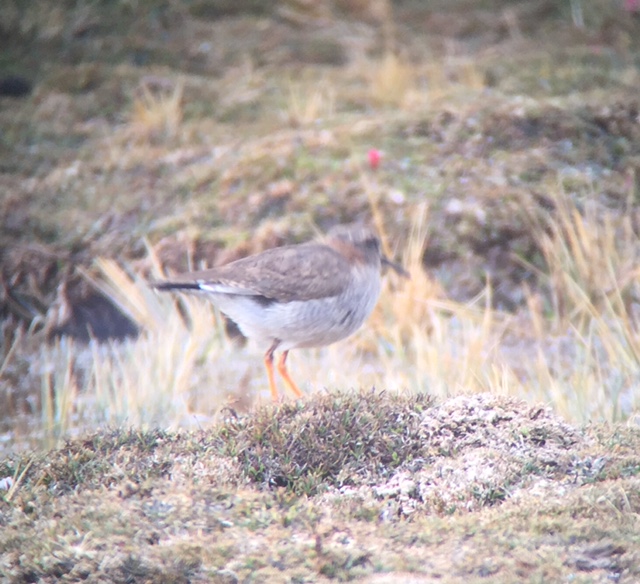
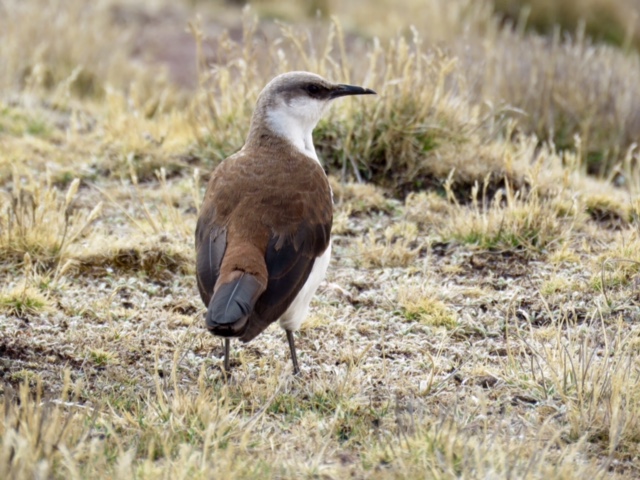
September 9th THE SHORES OF LAGO JUNIN
We started our day by trying to see the critically endangered Junin Grebe from a lookout point overlooking Lake Junin. Both Miguel and I knew this would be impossible, but we had to give it a try. Ten years ago I did the same, but back then it was impossible to say anything about bill length or head shape – the only way to separate it from the far more common and very similar Silvery Grebe – since the birds were almost a kilometre away (the Junin Grebe does never venture into the shallows and always stays in the deep water after the furthest reed beds). So ten years ago we hired a small boat and spend half the day looking for the grebe in the deep part of the lake, a fun adventure with huge success! This time I didn’t have the time or the money so in my mind I had already dismissed the possibility of seeing the grebe again. Anyways we tried and with 60 x magnification I scanned through flocks of coots and grebes in the far distance. Conclusion, no chance in hell :). We couldn’t even see the bill of any of these birds let alone say anything about length and shape. We quickly picked up the endemic Black-breasted Hillstar and headed north to Hunanaco. En route we stopped in a dry valley where we saw our second species of Inca-finch this trip, the Rufous-backed Inca-finch.
We arrived in Huanaco around 4 PM and with 2 hours to kill Miguel opted to already drive up to Bosque Unchog and camp there, so that we would be in Golden-backed Mountain-tanager country at first light the next day.
We arrived just before dusk, set up tent, enjoyed dinner prepared by Miguel and Juve on the stove and tucked in for a freezing cold night…
September 10th LIFE BEFORE SEEING THE GOLDEN-BACKED MOUNTAIN-TANAGER
Ten years ago Vincent van der Spek, Jelmer Poelstra and I spent a full day in cold, wet and generally miserable weather looking for the Golden-backed Mountain-tanager at Bosque Unchog. Back then we had to leave the mountain empty handed, a dip that haunted all three of us for quite some time. So today I got the chance to finally redeem myself.
At 5:30 AM I couldn’t hold myself much longer – it was bloody cold anyhow – so I stepped out of our tent and started chasing some sounds. Undulated Antpitta, Neblina- and Tschudi’s Tapaculo and Many-striped Canastero were all heard, but I only managed to see the latter.
We had breakfast and braced ourselves for the Mountain-tanager quest. As we walked past the first elfin forest patches towards the gorge where the Unchog Big 4 – Golden-backed Mountain-tanager, Rufous-browed Hemispingus, Bay-vented Cotinga and Pardusco – are most regularly reported, we picked up Tschudi’s Tapaculo, White-chinned Thistletail and the endemic Coppery Metaltail. Best was a flyby White-throated Hawk.
The first of the big 4 and a bird I’d missed last time was a fantastic pair of Bay-vented Cotinga picked up by Miguel on call, a good start! Then things quickly slowed down and by 11 AM we had only found Pardusco and Taczanowski’s Chat-tyrant.
By 2 PM I was getting desperate and knew that I would probably dip the Tanager for the second time in my life. By 4 PM I had given up. Mentally and physically broken Miguel and I started to walk back to the car where Juve and Camilla where waiting (they’d walked back a little earlier to break up camp). Along the way we flushed a very welcome Andean Snipe.
Then is happened… At the very last elfin forest patch I picked up on a movement in a tree. I aimed my binoculars and saw something large and bright yellow. GOLDEN-BACKED MOUNTAIN-TANAGER!!! 3 Birds together! I couldn’t believe my eyes. Miguel and I were dancing on the trail and quickly called Camilla on the walky-talky. I saw Camilla approaching in the distance, but the birds started to move… Would she make it in time?? Yes! In the nick of time, completely out of breath Camilla got one very good look of all three Mountain-tanagers before they vanished over the ridge. Mission accomplished!
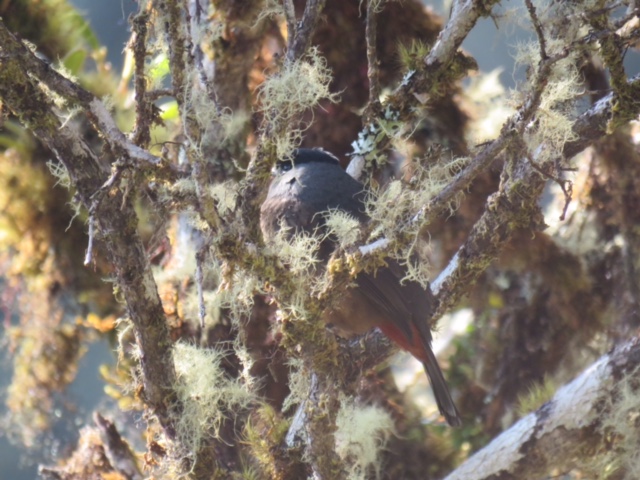
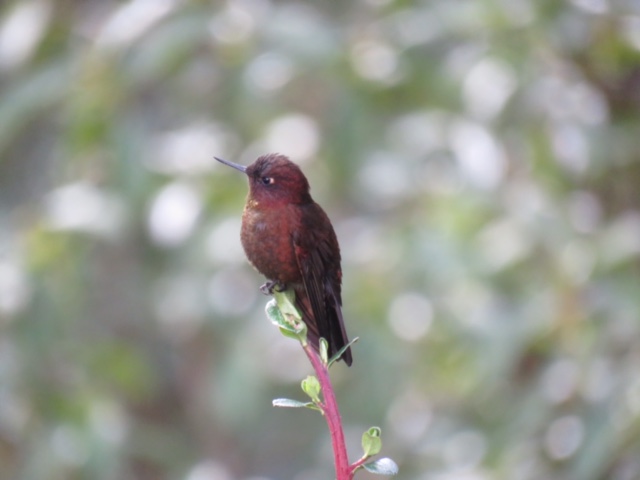
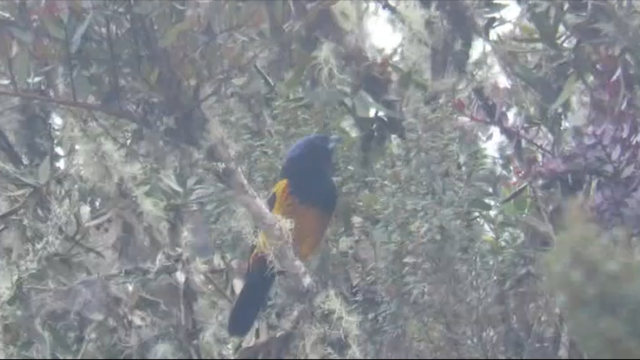
September 11th LIFE AFTER SEEING THE GOLDEN-BACKED MOUNTAIN-TANAGER
When I woke up today I was still thinking about that awesome Mountain-tanager from yesterday, what an amazing bird! Anyways, back to business…
We started our day above the famous Carpish Tunnel where we tried for two endemic antpittas, Bay Antpitta and Chestnut Antpitta. Upon arrival it was a sad sight that most of the once pristine cloud forest had been cleared to make way for Hortensia plantations. To me it is unbelievable that beautiful rainforest is cleared so that people can have some colourful flowers in their living room. Since the forest around this area is completely unprotected it won’t take long before all the hillsides are covered with these plantations. While we were there the whole valley was covered in smoke caused by set fires to clear the forest. Ironically the ‘clouds’ of the cloud forest have been replaced by smoke.
Luckily we managed to track down the two endemic Antpittas, the endemic Large-footed Tapaculo and Peruvian Wren in the remaining forest patches above the tunnel. I was especially pleased with an extremely cool Buff-tailed Sicklebill feeding on some flowers next to the track and a stunning pair of Streak-headed Antbirds.
The Paty Trail is also loosing its once legendary birding status due to deforestation in the area. Still we gave it a go to look for the endemic Peruvian Tyrannulet which luckily proved not too difficult. Other nice finds were Flame-faced Tanager and Rufous-winged Barbtail.
By midday we started heading north towards Tarapoto, a long drive that would take us two half days.
September 12th A PIMP-ASS POTOO
After spending the night in Tocache – a town half way between Huanaco and Tarapoto – we hit the road again. Around midday we hit a roadblock caused by a strike. Considering the fact that these roadblocks can last for over 24 hours we were lucky that the road opened up after just half an hour of waiting. So around 2 PM we arrived at Aconabick, a community run private property famous for having some fantastic hummingbird feeders which attract the endemic Koepcke’s Hermit.
The feeders were indeed fantastic and within half an hour we recorded 15 species of hummingbird including Pale-tailed Barbthroat, Great-billed Hermit, Long-billed Starthroat, Rufous-breasted Hermit and of course several Koepcke’s Hermits. After we finally managed to drag Camilla away from the feeders we set foot on the trail system behind the property. Our big target here was a roosting Long-tailed Potoo which had been discovered here 1,5 years ago. The bird had been lost for a while, but luckily for us it was re-found just two months prior to our arrival.
After walking for 15 minutes or so we arrived at the spot where we immediately saw this amazing bird perched perfectly camouflaged on a branch inside the forest. What an incredible sighting!
From Aconabick we drove down to Tarapoto where we spent the night.
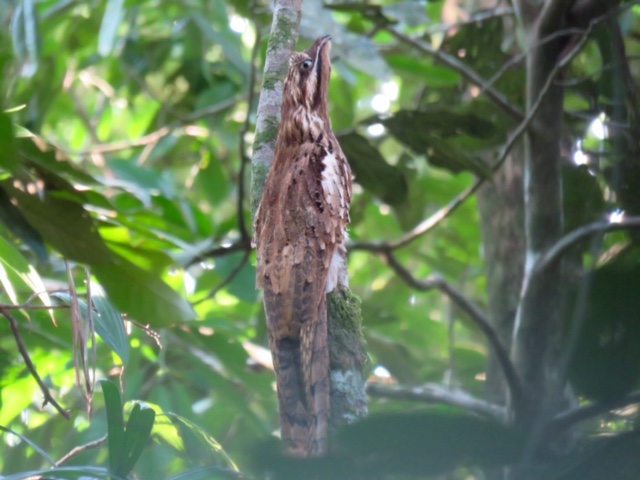
September 13th THE TUNNEL
Early morning we drove up from Tarapoto to the famous tunnel area, which lies at about 1200 meters altitude on an isolated ridge. This area holds some peculiar bird species with a poorly know and patchy distribution on similar ridges throughout the northern Amazon basin. Shortly after sunrise we found our first flock, which held several different species of Euphonia and since the very rare Plumbeous Euphonia has been recorded from this area Miguel played some tape. To our amazement we got a response. We quickly located the bird and for the next ten minutes we got ridiculous eye-level views of this mega rarity, which was the first lifer this trip for Miguel.
Other good birds this morning around the tunnel were Dotted Tanager, three Golden-collared Toucanets, Rose-fronted Parakeet and a stunning Black-and-white Hawk-eagle.
En Route to Moyabamba we made a quick stop in the peculiar dry forest around Juan Guera, a small village south of Tarapoto. Here we found the range restricted (Huallaga) Northern Slaty Antshrike and Sulphur-bellied Tyrant-manakin.
The most awesome sighting of the day was at a small bridge over a steep gorge from where we had fantastic scope-views of several dozens of Oilbirds – a monotypic species of nightbird that looks like a crossbreed between a nightjar and a hawk.
In the late afternoon we arrived at the wonderful Waqanki Lodge, which lies at the base of an islolated ridge with some very cool and very range restricted bird species, but these had to wait for tomorrow morning. We spent the afternoon at a leisurely pace around the hummingbird feeders where we saw a dazzling male Rufous-crested Coquette and several Black-throated Hermits. Other goodies around the premises were the newly described Varzea Thrush, the endemic Mishana Tyrannulet and the poorly known Sooty-headed Tyrannulet.
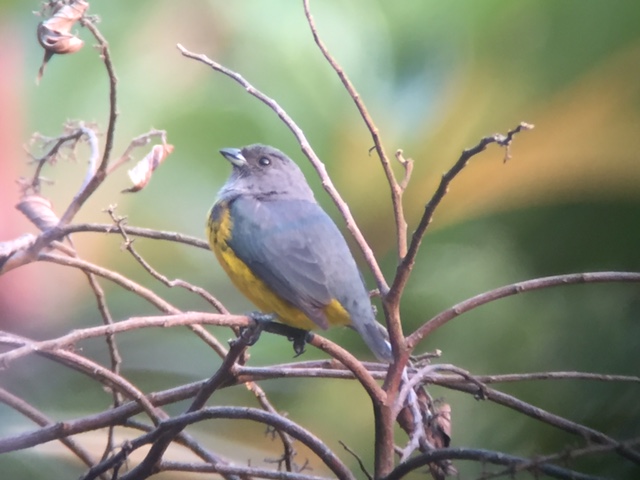
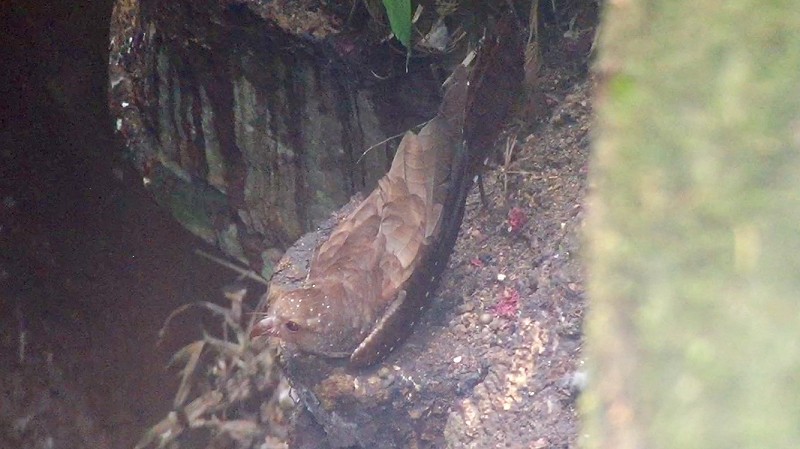
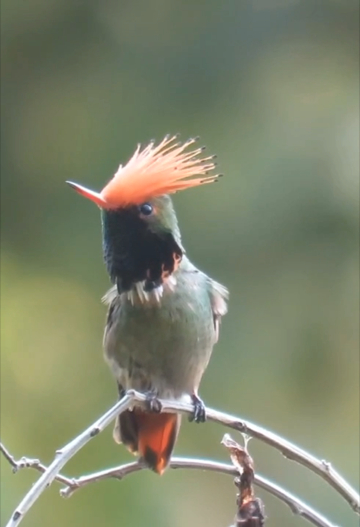 Rufous-crested Coquette Lophornis delattrei (Arjan Dwarshuis)
Rufous-crested Coquette Lophornis delattrei (Arjan Dwarshuis)
September 14th THE LONG-WHISKERED OWLET!
Another huge day which will be difficult to summarize in a few paragraphs, but I’ll give it a try 🙂
At 5 AM Miguel and I started walking up to the ridge high above Waqanki Lodge, which is currently the only place to find the endemic and endangered Ash-throated Antwren. Camilla decided to spend the morning at Waqanki so she could have some more time with all those amazing hummingbirds.
The three hour walk to the ridge is steep and quite tough, but along the way we managed to find some fantastic birds like Chestnut-throated Spinetail, Black-and-white Tody-tyrant, Tawny-throated Leaftosser and Red-billed Tyrannulet.
We arrived at the ridge around 9 AM, perfectly on schedule. Here we began our search for the Antwren. For half an hour or so we didn’t get any response, but luckily there was a splendid Broad-billed Motmot to keep me busy. Suddenly we heard the Antwren calling from further up the ridge and after some playback we got incredible views of this hard to find specialty.
We took another route down through dryer forest where we found our target – the Northern Chestnut-tailed Antbird without too much difficulty.
From Waqanki we started heading up towards Afluente, a small village at 1200 meters on the eastern slope below the famous Alto Mayo NP. En route we had lunch at a swamp near Moyabamba, where we found two very good birds, Pale-eyed Blackbird and Black-billed Seed-finch.
As we drove up towards Afluente dark clouds packed over the mountains, not a good sign as tonight we would try for the enigmatic Long-whiskered Owlet, one of my most-wanted birds for this whole year.
In the single hour of daylight we had left we found a big flock just above Afluente which held a nice selection of tanagers and the rare Ecuadorian Tyrannulet. Our main target at Afluente was the Ecuadorian Piedtail, an uncommon and range-restricted hummer which can often be tricky to find, until now! A young boy has started a small business with a couple of hummingbird feeders and these attract the Piedtail. So after five minutes of waiting we had the Piedtail plus bonus Green Hermit in the bag.
Our bird of the day – and possibly of the trip – had to be found after dusk, namely the Long-whiskered Owlet, but if it’s raining; no way… We first had dinner at the tiny settlement of Funda Alto Nieva – where we would also spend the night. Then it was time to begin our owlet-quest. By now a thunderstorm was well on its way and roaring thunder and lightning now and then lit up the forest like a Christmas tree. Not ideal conditions for finding a 13 cm, very rare owlet with a call like a frog. Anyway we gave it a go and I kept my fingers crossed as we set of into the elfin forest with a local guide. After 20 minutes of walking across a slippery track we arrived at the first spot. I held my breath as Miguel played the tape, but after 15 minutes there wasn’t a single response. We tried a next spot while the thunderstorm was approaching, I counted just 3 seconds between lighting and thunder… No response at the next spot. One more site to go, but would we still have time? It now started to rain lightly… Suddenly the Owlet responded! A soft but clearly recognisable ‘prrroow’. We chased the sound with our torches, but it had already moved. This went on for at least half an hour, but then ‘Bang!’ we got it in the torch beam! Unfortunately from the rear, but you could clearly see the whiskers pop out! Yes! Barely 5 minutes after this sighting it started pouring down heavily. We had been just in time, unbelievable! And I almost forgot, we also saw a fantastic Cinnamon Screech-owl. What a memorable day!
September 15th THE RARITIES OF THE STUNTED FOREST
After quite a cold night sleeping on a wooden mattress we had breakfast. It had rained heavily for most of the night, but as luck happens to be the rain had stopped and birds were singing!
Our first and my most wanted target of today was the endemic and endangered Ochre-fronted Antpitta. This species – along with Bar-winged Wood-wren, the Owlet, Cinnamon-breasted Tody-tyrant and Royal Sunangel – is only found in the peculiar stunted elfin-like forest in northern Peru. What makes this forest and the niche that these birds occupy so special is that it is elfin-type forest at just 1500 meters. Normally one would expect this type of forest above 3000 meters just below the treeline. Apparently the humidity and the relatively cold temperatures enabled this forest to develop in such a peculiar way.
We arrived at a bamboo and moss dominated spot in the forest and started playing the call of the Antpitta and after about 15 minutes we got a response. Slowly the bird got closer and we all tried to focus through the undergrowth to get a view. Suddenly the bird popped up and gave a brief but incredible view, but only for me unfortunately. The bird didn’t show a second time.
The Wood-wren and the Tody-tyrant were found fairly quickly so next we went to the hummingbird feeders to hopefully see the Royal Sunangel – which is far from guaranteed here. We had luck on our hands and after just ten minutes of waiting we got unbelievable views of a male Sunangel!
Next we went 300 meters downhill to look for some nice flocks, since we still needed a couple of birds from the lower altitudes. And we did find a flock, one of the best flocks I’d ever seen with Olivaceous Piha, Black-throated Toucanet, Scarlet-rumped Cacique, Blue-browed Tanager and a stunning male Vermillion Tanager, wow!
We spent the rest of the day slowly traveling and birding up towards the Owlet Lodge near Abra Patricia. We arrived at this amazing lodge with two hours to kill so we went on the trails. A great choice since we found a smashing male Lulu’s Tody-flycatcher.
We ended yet another fantastic day in style with a Sword-billed Hummingbird at the feeders and of course and owl, namely a beautiful White-throated Screech-owl!
Arjan Dwarshuis
http://www.arjandwarshuis.com/#biggestyear
http://world.observation.org/arjan.php
PLEASE MAKE A DONATION NOW
